Barron's SAT, 26th edition (2012)
Part 4. TEST YOURSELF
Chapter 10. Five Model SAT Tests
Model Test 5
Answer Sheet—Test 5
Section 1 ESSAY

Section 2

Section 3

Section 4

Section 6

Section 7
![]()
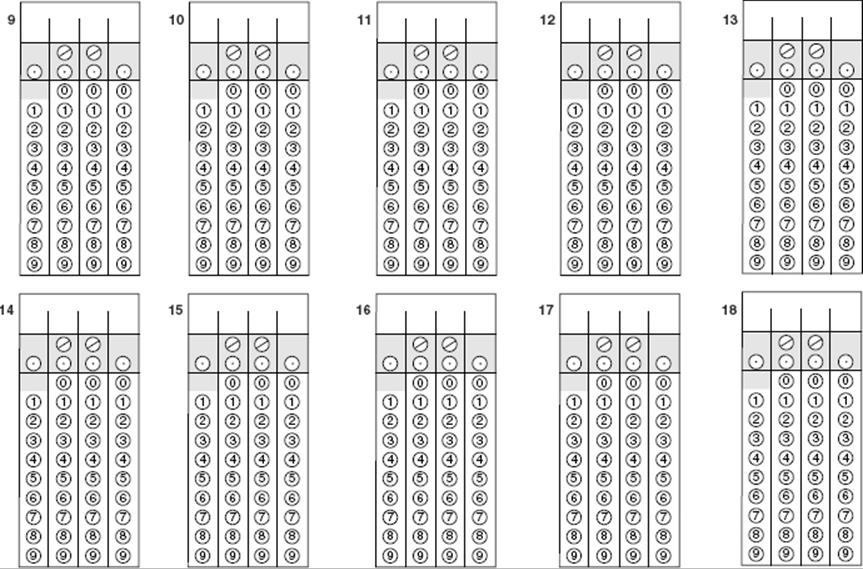
Section 8

Section 9

Section 10

Test 5
SECTION 1
Time—25 Minutes
ESSAY
The excerpt appearing below makes a point about a particular topic. Read the passage carefully, and think about the assignment that follows.
In her novel Sense and Sensibility, Jane Austen wrote, “It is not time or opportunity that is to determine intimacy. Seven years would be insufficient to make some people acquainted with each other, and seven days are more than enough for others.” Now Austen may have been writing somewhat tongue in cheek, for she attributes these sentiments to the excessively romantic Marianne Dashwood, whose extreme sensibility or emotional susceptibility gets its comeuppance by the novel’s end. Nonetheless, the point that young Miss Dashwood makes is valid. No amount of time spent in another person’s company can guarantee that the two of you will become friends.
ASSIGNMENT: What are your thoughts on the idea that neither time nor opportunity can determine intimacy? What causes two people to become friends? Compose an essay in which you express your views on this topic. Your essay may support, refute, or qualify the views expressed in the excerpt.
What you write, however, must be relevant to the topic under discussion. Additionally, you must support your viewpoint, indicating your reasoning and providing examples based on your studies and/or experience.
SECTION 2
Time—25 Minutes 24 Questions
Select the best answer to each of the following questions; then blacken the appropriate space on your answer sheet.
Each of the following sentences contains one or two blanks; each blank indicates that a word or set of words has been left out. Below the sentence are five words or phrases, lettered A through E. Select the word or set of words that best completes the sentence.
Example:
Fame is ----; today’s rising star is all too soon tomorrow’s washed-up has-been.
(A) rewarding
(B) gradual
(C) essential
(D) spontaneous
(E) transitory
![]()
1. His critical reviews were enjoyed by many of his audience, but the subjects of his analysis dreaded his comments; he was vitriolic, devastating, irritating and never --.
(A) analytic
(B) personal
(C) constructive
(D) uncharitable
(E) controversial
2. Despite the team members’ resentment of the new coach’s training rules, they ---- them as long as he did not ---- them too strictly.
(A) embraced..follow
(B) condemned..formulate
(C) questioned..interpret
(D) challenged..implement
(E) tolerated..apply
3. Given the ---- state of the published evidence, we do not argue here that exposure to low-level microwave energy is either hazardous or safe.
(A) inconclusive
(B) satisfactory
(C) definitive
(D) immaculate
(E) exemplary
4. Tacitus’ descriptions of Germanic tribal customs were ---- by the ---- state of communications in his day, but they match the accounts of other contemporary writers.
(A) defined..inconsequential
(B) limited..primitive
(C) enriched..antiquated
(D) contradicted..thriving
(E) muddled..suspended
5. No matter how ---- the revelations of the coming years may be, they will be hard put to match those of the past decade, which have ---- transformed our view of the emergence of Mayan civilization.
(A) minor..dramatically
(B) profound..negligibly
(C) striking..radically
(D) bizarre..nominally
(E) questionable..possibly
6. Because of its inclination to ----, most Indian art is ---- Japanese art, where symbols have been minimized and meaning has been conveyed by the merest suggestion.
(A) exaggerate..related to
(B) imitate..superior to
(C) understate..reminiscent of
(D) overdraw..similar to
(E) sentimentalize..supportive of
7. Irony can, after a fashion, become a mode of escape: to laugh at the terrors of life is in some sense to ---- them.
(A) overstate
(B) revitalize
(C) corroborate
(D) evade
(E) license
8. The campus police who monitored the demonstrations had little respect for the student protesters, generally speaking of them in ---- terms.
(A) hyperbolic
(B) euphemistic
(C) pejorative
(D) derivative
(E) uncertain
Read each of the passages below, and then answer the questions that follow the passage. The correct response may be stated outright or merely suggested in the passage.
Questions 9 and 10 are based on the following passage.
Did she or didn’t she? From the 1950s popular
song lyrics proclaiming that
Captain Smith and Pocahontas
Had a very mad affair
Line (5) to the 1995 Walt Disney animated film, the
legend of Pocahontas has been widely popular in
American culture. But the romance between John
Smith and the Indian chieftain’s daughter appears
to have been a total fabrication. True, young
(10) Matoaka, whose pet name was Pocahontas
(“favorite daughter”), interceded to save Smith’s
life, but she was only 11 at the time; and though
she eventually married an Englishman named
John, his surname was Rolfe, not Smith.
9. The author’s primary purpose in this paragraph is to
(A) debunk a common myth
(B) refute a challenge to an argument
(C) encourage us to identify with historical figures
(D) celebrate a legendary romance
(E) distinguish between history and drama
10. The word “True” in line 9 primarily serves to acknowledge the
(A) existence of a relationship between Pocahontas and Smith
(B) high esteem in which Pocahontas was held by her father
(C) lack of information about Matoaka’s actual emotions
(D) authoritative nature of the Disney animated version
(E) enduring popularity of legendary heroic figures
Questions 11 and 12 are based on the following passage.
The Mayans and Aztecs considered chocolate
the food of the gods, but today’s lovers of sweets
would not find the earliest chocolate heavenly.
Chocolate is made from the roasted and ground
Line (5) seeds of the cacao tree. Until the sixteenth
century, ground chocolate was mixed with water and
spices, including chili peppers, to make a bitter,
frothy beverage that Spanish explorers termed fitter
for hogs than men. Not until Cortez brought
(10) chocolate back to Spain in 1526 was sugar added
to the mix, but once it was, European royalty
prized hot chocolate drinks. Over the next two
centuries, hot chocolate became fashionable;
chocolate houses (like coffeehouses) sprang up
(15) throughout Europe.
11. The opening sentence of the passage makes use primarily of which of the following?
(A) Humorous understatement
(B) Classical allusion
(C) Personification
(D) Allegory
(E) Simile
12. The initial attitude of the Spaniards toward the Aztec chocolate beverage can best be characterized as
(A) appreciative
(B) indifferent
(C) objective
(D) derisive
(E) nostalgic
Questions 13–24 are based on the following passage.
In this excerpt from his autobiographical Narrative of the Life of an American Slave, the abolitionist Frederick Douglass tells how he, as a young child, learned the value of learning to read and write.
Mr. and Mrs. Auld were both at home, and met
me at the door with their little son Thomas, to
take care of whom I had been given. And here I
saw what I had never seen before; it was a white
Line (5) face beaming with the most kindly emotions;
it was the face of my new mistress, Sophia Auld. I
wish I could describe the rapture that flashed
through my soul as I beheld it. It was a new and
strange sight to me, brightening up my pathway
(10) with happiness. Little Thomas was told, there was
his Freddy, and I was told to take care of little
Thomas; and thus I entered upon the duties of my
new home with the most cheering prospect
ahead.
(15) My new mistress proved to be all she appeared
when I first met her at the door—a woman of the
kindest heart and feelings. She had never had a
slave under her control previously to myself, and
prior to her marriage she had been dependent
(20) upon her own industry for a living. She was by
trade a weaver; and by constant application to her
business, she had been in a good degree preserved
from the blighting and dehumanizing effects of
slavery. I was utterly astonished at her goodness.
(25) I scarcely knew how to behave towards her. My
early instruction was all out of place. The crouching
servility, usually so acceptable a quality in a
slave, did not answer when manifested toward
her. Her favor was not gained by it; she seemed to
(30) be disturbed by it. She did not deem it impudent
or unmannerly for a slave to look her in the face.
The meanest slave was put fully at ease in her
presence, and none left without feeling better for
having seen her. But alas! this kind heart had but
(35) a short time to remain such. The fatal poison of
irresponsible power was already in her hands, and
soon commenced its infernal work.
Very soon after I went to live with Mr. and
Mrs. Auld, she very kindly commenced to teach
(40) me the A, B, C. After I had learned this, she
assisted me in learning to spell words of three or
four letters. Just at this point of my progress, Mr.
Auld found out what was going on, and at once
forbade Mrs. Auld to instruct me further, telling
(45) her that it was unlawful, as well as unsafe, to
teach a slave to read. Further, he said, “If you
give a slave an inch, he will take an ell. A slave
should know nothing but to obey his master—to
do as he is told to do. Learning would spoil the
(50) best slave in the world. Now,” said he, “if you
teach that boy (speaking of myself) how to read,
there would be no keeping him. It would forever
unfit him to be a slave. He would at once become
unmanageable, and of no value to his master. As
(55) to him, it could do him no good, but a great deal
of harm. It would make him discontented and
unhappy.” These words sank deep into my heart,
stirred up sentiments within that lay slumbering,
and called into existence an entirely new train of
(60) thought. I now understood what had been to me a
most perplexing difficulty—to wit, the white
man’s power to enslave the black man. From that
moment I understood the pathway from slavery to
freedom. Though conscious of the difficulty of
(65) learning without a teacher, I set out with high
hope, and a fixed purpose, at whatever cost of
trouble, to learn how to read. The very decided
manner with which my master spoke, and strove
to impress his wife with the evil consequences of
(70) giving me instruction, served to convince me that
he was deeply sensible of the truths he was uttering.
It gave me the best assurance that I might
rely with the utmost confidence on the results
which, he said, would flow from teaching me to
(75) read. What he most dreaded, that I most desired.
What he most loved, that I most hated. That
which to him was a great evil, to be carefully
shunned, was to me a great good, to be diligently
sought; and the argument which he so warmly
(80) urged, against my learning to read, only served to
inspire me with a desire and determination to
learn. In learning to read, I owe almost as much
to the bitter opposition of my master, as to the
kindly aid of my mistress. I acknowledge the
(85) benefit of both.
13. According to the opening paragraph, the author’s initial reaction toward joining the Aulds’ household was primarily one of
(A) absolute astonishment
(B) marked pleasure
(C) carefree nonchalance
(D) quiet resignation
(E) subdued nostalgia
14. To some degree, the author attributes Mrs. Auld’s freedom from the common attitudes of slave owners to her
(A) abolitionist upbringing
(B) personal wealth
(C) indifference to her husband
(D) experiences as a mother
(E) concentration on her trade
15. Which of the following best explains why the author felt his “early instruction was all out of place” (line 26)?
(A) It failed to include instruction in reading and writing.
(B) It did not prepare him to take adequate care of the Aulds’ son Thomas.
(C) It did not train him to assist Mrs. Auld with her weaving.
(D) It had been displaced by the new instructions he received from the Aulds.
(E) It insisted on an obsequiousness that distressed his new mistress.
16. In line 28, “answer” most nearly means
(A) acknowledge
(B) retort
(C) reply
(D) serve
(E) atone
17. By “this kind heart had but a short time to remain such” (lines 34 and 35) the author primarily intends to convey that Mrs. Auld
(A) had only a brief time in which to do her work
(B) was fated to die in the near future
(C) was unable to keep her temper for extended periods of time
(D) had too much strength of will to give in to the softer emotions
(E) was destined to undergo a change of character shortly
18. It can be inferred from the passage that all of the following were characteristic of Mrs. Auld at the time the author first met her EXCEPT
(A) diligence in labor
(B) dislike of fawning
(C) gentleness of spirit
(D) disdain for convention
(E) benevolent nature
19. For which of the following reasons does Mr. Auld forbid his wife to educate her slave?
I. Providing slaves with an education violates the law.
II. He believes slaves lack the capacity for education.
III. He fears education would leave the slave less submissive.
(A) I only
(B) III only
(C) I and II only
(D) I and III only
(E) I, II, and III
20. We can assume on the basis of Mr. Auld’s comment in lines 46 and 47 that
(A) he is willing to give his slaves the inch they request
(B) he uses the term ell to signify a letter of the alphabet
(C) Mrs. Auld is unfamiliar with standard forms of measurement
(D) an ell is a much larger unit of length than an inch
(E) slaves are far less demanding than he realizes
21. The author’s main purpose in this passage is to
(A) describe a disagreement between a woman and her husband
(B) analyze the reasons for prohibiting the education of slaves
(C) describe a slave’s discovery of literacy as a means to freedom
(D) dramatize a slave’s change in attitude toward his mistress
(E) portray the moral downfall of a kindhearted woman
22. In line 71, “sensible” most nearly means
(A) logical
(B) prudent
(C) intelligent
(D) conscious
(E) sensory
23. The tone of the author in acknowledging his debt to his master (lines 82–85) can best be described as
(A) sentimental and nostalgic
(B) cutting and ironic
(C) petulant and self-righteous
(D) resigned but wistful
(E) angry and impatient
24. Which of the following definitions of “education” is closest to the author’s view of education as presented in the passage?
(A) Education makes people easy to govern, but impossible to enslave.
(B) Education is the best provision for old age.
(C) Education has for its object the formation of character.
(D) Education has produced a vast population able to read but unable to distinguish what is worth reading.
(E) Education begins and ends with the knowledge of human nature.
S T O P
YOU MAY GO BACK AND REVIEW THIS SECTION IN THE REMAINING TIME, BUT DO NOT WORK IN ANY OTHER SECTION UNTIL TOLD TO DO SO.
SECTION 3
Time—25 Minutes 20 Questions
For each problem in this section determine which of the five choices is correct and blacken the corresponding choice on your answer sheet. You may use any blank space on the page for your work.
Notes:
• You may use a calculator whenever you think it will be helpful.
• Only real numbers are used. No question or answer on this test involves a complex or imaginary number.
• Use the diagrams provided to help you solve the problems. Unless you see the words “Note: Figure not drawn to scale” under a diagram, it has been drawn as accurately as possible. Unless it is stated that a figure is three-dimensional, you may assume it lies in a plane.
• For any function f, the domain, unless specifically restricted, is the set of all real numbers for which f (x) is also a real number.
Reference Information
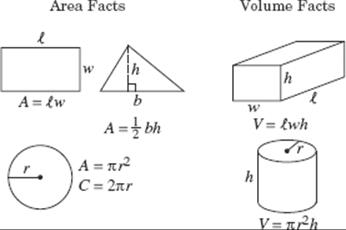
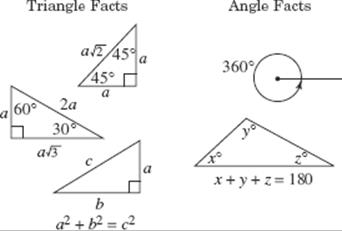
1. If a – 5 = 0, what is the value of a + 5?
(A) –10
(B) –5
(C) 0
(D) 5
(E) 10
2. What is 50% of 50% of 50?
(A) 0.125
(B) 0.5
(C) 1.25
(D) 5.0
(E) 12.5
3. Which of the following is an expression for “the product of 5 and the average (arithmetic mean) of x and y”?
(A) ![]()
(B) ![]()
(C) ![]()
(D) ![]()
(E) ![]()
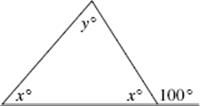
Note: Figure not drawn to scale
4. In the figure above, what is the value of y?
(A) 20
(B) 40
(C) 45
(D) 50
(E) 80
5. Assume that light travels at 300,000 kilometers per second, and the sun is 150,000,000 kilometers from Earth. How many minutes does it take for light to travel from the sun to Earth?
(A) 0.002
(B) 0.12
(D) ![]()
(D) 20
(E) 500
6. If it is now 1:15, what time will it be when the hour hand has moved through an angle of 10°?
(A) 1:25
(B) 1:35
(C) 2:15
(D) 3:15
(E) 11:15
7. If d is the length of a diagonal of a square, what does d 2represent?
(A) the area of the square
(B) twice the area of the square
(C) ![]() the area of the square
the area of the square
(D) 4 times the area of the square
(E) ![]() the area of the square
the area of the square
8. If a < b < c < d and the average (arithmetic mean) of a, b, c, and d is 10, which of the following MUST be true?
I. a + d = b + c
II. a < 10 and d > 10
III. b < 10 and c > 10
(A) I only
(B) II only
(C) I and II only
(D) I and III only
(E) I, II, and III
9. A woman takes a horse out of a stable and rides it 3 miles north, 8 miles east, and then 3 miles north again to her house. How far is it, in miles, from the stable to her house?
(A) 10
(B) 12
(C) 14
(D) 15
(E) 16
10. Two sides of a right triangle are 5 and 6. Which of the following could be the length of the third side?
I. ![]()
II. ![]()
III. ![]()
(A) I only
(B) III only
(C) I and II only
(D) I and III only
(E) I, II, and III
Questions 11 and 12 refer to the following definition.
For any numbers a, b, and c,
![]() = abc − (a + b +c).
= abc − (a + b +c).
11. ![]() = ?
= ?
(A) 0
(B) 5
(C) 10
(D) 20
(E) 30
12. For which of the following equations is it true that there is exactly one positive integer that satisfies it?
I. ![]() = 0
= 0
II. ![]() = 0
= 0
III. ![]() = 0
= 0
(A) None
(B) I only
(C) III only
(D) I and III only
(E) I, II, and III
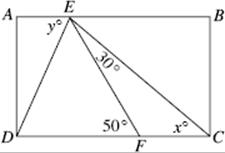
Note: Figure not drawn to scale
13. In the figure above, rectangle ABCD has been partitioned into four triangles. If DF = EF, what is the value of x + y?
(A) 60
(B) 75
(C) 85
(D) 90
(E) 105
14. Megan wrote down all of the three-digit numbers that can be written using each of the numerals 1, 2, and 3 exactly once. What is the average (arithmetic mean) of the numbers that Megan wrote?
(A) 213
(B) 222
(C) 231
(D) 233
(E) 333
15. If f(x) = x2 – 1 and g(x) = 1 – x2, then for which of the following values of a does f(2a) – 7 = g(2a) + 7?
(A) 0
(B) 1
(C) ![]()
(D) ![]()
(E) 7
16. The population density of a region is the number of people living in the region per square mile. Jackson County is a rectangle whose length is ![]() miles and whose width is w miles. How many people live in Jackson County if its population density is d?
miles and whose width is w miles. How many people live in Jackson County if its population density is d?
(A) d ![]() w
w
(B) ![]()
(C) ![]()
(D) ![]()
(E) ![]()
17. If A is point (– 4,1) and B is point (2,1), what is the area of the circle that has AB as a diameter?
(A) 3![]()
(B) 6![]()
(C) 9![]()
(D) 12![]()
(E) 36![]()
18. Mrs. James gave a test to her two geometry classes. The 24 students in her first-period class had a class average (arithmetic mean) of 78. The average of the 26 students in her second-period class was 83. What was the average for all students taking the exam?
(A) 79.4
(B) 80.5
(C) 80.6
(D) 81.2
(E) 81.4
19. If x = 2y – 5 and z = 16y3, what is z in terms of x?
(A) ![]()
(B) ![]()
(C) 2(x + 5)3
(D) 4(x + 5)3
(E) 8(x + 5)3
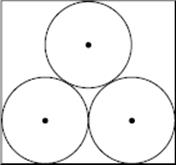
20. In the figure above, each circle is tangent to the other two circles and to the sides of the rectangle. If the diameter of each circle is 10, what is the area of the rectangle?
(A) 300
(B) 400
(C) 100 + 200 ![]()
(D) 200 + 100 ![]()
(E) It cannot be determined from the information given.
S T O P
YOU MAY GO BACK AND REVIEW THIS SECTION IN THE REMAINING TIME, BUT DO NOT WORK IN ANY OTHER SECTION UNTIL TOLD TO DO SO.
SECTION 4
Time—25 Minutes 35 Questions
Select the best answer to each of the following questions; then blacken the appropriate space on your answer sheet.
Some or all parts of the following sentences are underlined. The first answer choice, (A), simply repeats the underlined part of the sentence. The other four choices present four alternative ways to phrase the underlined part. Select the answer that produces the most effective sentence, one that is clear and exact, and blacken the appropriate space on your answer sheet. In selecting your choice, be sure that it is standard written English, and that it expresses the meaning of the original sentence.
Example:
The first biography of author Eudora Welty came out in 1998 and she was 89 years old at the time.
(A) and she was 89 years old at the time
(B) at the time when she was 89
(C) upon becoming an 89 year old
(D) when she was 89
(E) at the age of 89 years old
![]()
1. Nowhere do the problems of urban decay seem more evident than in this dying city.
(A) Nowhere do the problems of urban decay seem more evident than in this dying city.
(B) Nowhere more than in this dying city is there evidence of the problems of urban decay.
(C) In this dying city, more so than in other places, they evidently seem to have problems of urban decay.
(D) The problems of urban decay do seem more evident in this dying city than other places.
(E) In this dying city, more so than elsewhere, the problems of urban decay are evident, it seems.
2. The average citizen today is surprisingly knowledgeable about landmark court decisions concerning such questions as affirmative action, reproductive rights, and whether students can pray in school.
(A) rights, and whether students can pray in school
(B) rights, and whether students could pray in school
(C) rights, or whether students can pray in school
(D) rights, and the issue of praying in school
(E) rights, and school prayer
3. Georgette Heyer is best known for her two dozen romances set in the Regency era, and her novel The Conqueror takes place over seven hundred years earlier at the time of the Battle of Hastings.
(A) Georgette Heyer is best known for her two dozen romances set in the Regency era, and
(B) Georgette Heyer is best known for her two dozen romances set in the Regency era, nevertheless
(C) Although Georgette Heyer is best known for her two dozen romances set in the Regency era,
(D) Georgette Heyer is best known for her two dozen romances set in the Regency era,
(E) Insofar as Georgette Heyer is best known for her two dozen romances set in the Regency era,
4. At an early stage in his travels, Henry James, writing from abroad, described the subtle differences distinguishing Americans from Europeans.
(A) At an early stage in his travels, Henry James writing
(B) At an early stage in his travels, Henry James wrote
(C) At an early stage in his travels, Henry James was written
(D) At an early stage in his travels, Henry James was writing
(E) Henry James, whose writing at an early stage in his travels
5. Fame as well as fortune were his goals in life.
(A) Fame as well as fortune were his goals in life.
(B) Fame as well as fortune was his goals in life.
(C) Fame as well as fortune were his goal in life.
(D) Fame and fortune were his goals in life.
(E) Fame also fortune were his goals in life.
6. For recreation I like to watch these kind of programs in the evening.
(A) these kind of
(B) these sort of
(C) these kinds of
(D) them kinds of
(E) this kind of a
7. Whatever the surface appearances at the moment may be, modern men are fundamentally less tolerant of despots then men of old.
(A) less tolerant of despots then men of old
(B) less tolerant of despots than of older men
(C) more intolerant of despots than of men of old
(D) more intolerant of despots then men in former years
(E) less tolerant of despots than were men of old
8. The method of how different viruses being transmitted from one patient to another depends on the particular viruses involved.
(A) of how different viruses being transmitted
(B) whereby the transmission of different viruses is
(C) by which different viruses are transmitted
(D) for different viruses that are being transmitted
(E) when different viruses being transmitted
9. The fierce competition for grades among premed students is because of wanting to be accepted by a top medical school.
(A) is because of wanting to be accepted by a top medical school
(B) is because of a desire to be accepted by a top medical school
(C) stems out of wanting to be accepted by a top medical school
(D) stems from the desire to be accepted by a top medical school
(E) is because of the desire for acceptance at a top medical school
10. Born in the days when no modest woman would admit to writing novels, Jane Austen’s name was allowed to appear on her books only after her death.
(A) Born in the days when no modest woman would admit to writing novels, Jane Austen’s name
(B) Because Jane Austen was born in the days when no modest woman would admit to writing novels, her name
(C) Although born in the days when no modest woman would admit to writing novels, Jane Austen’s name
(D) Having been born in the days when no modest woman would have admitted to writing novels, Jane Austen
(E) Born in the days when a modest woman would not have admitted to writing novels, Jane Austen’s name
11. For a politically committed filmmaker like Michael Moore, being free to denounce society’s ills is more important than gaining commercial success.
(A) being free to denounce society’s ills is more important than
(B) there is greater importance in the freedom to denounce the ills of society than there is in
(C) being free to denounce society’s illnesses is more important, and then
(D) freedom to denounce society’s ills has more importance than does
(E) the free denunciation of society’s ills importantly is more than
The sentences in this section may contain errors in grammar, usage, choice of words, or idioms. Either there is just one error in a sentence or the sentence is correct. Some words or phrases are underlined and lettered; everything else in the sentence is correct.
If an underlined word or phrase is incorrect, choose that letter; if the sentence is correct, select No error.
Then blacken the appropriate space on your answer sheet.
Example:
The region has a climate ![]() plants
plants ![]() rarely
rarely ![]() more than twelve inches
more than twelve inches ![]() .
.![]()
![]()
12. This multimedia exhibition, ![]() worldwide
worldwide ![]() the centenary of Balanchine’s birth,
the centenary of Balanchine’s birth, ![]() photographs, designs, costumes, and set models,
photographs, designs, costumes, and set models, ![]() videotapes and excerpts from oral histories in the Library of Performing Arts.
videotapes and excerpts from oral histories in the Library of Performing Arts. ![]()
13. The Mozart Myths ![]() scholars have revised their predecessors’ findings, selecting material that might support their own pet theories, and depicting Mozart,
scholars have revised their predecessors’ findings, selecting material that might support their own pet theories, and depicting Mozart, ![]() ,
, ![]() a childish victim, a Romantic genius, and an Enlightenment rebel.
a childish victim, a Romantic genius, and an Enlightenment rebel. ![]()
14. ![]() the example of the Orpheus chamber orchestra, this
the example of the Orpheus chamber orchestra, this ![]() formed
formed ![]() young B conservatory graduates
young B conservatory graduates ![]() without a conductor.
without a conductor. ![]()
15. To ![]() Americans, the notion that free markets and democracy are
Americans, the notion that free markets and democracy are ![]() curing the world’s ills
curing the world’s ills ![]() an
an ![]() faith.
faith. ![]()
16. What better word ![]() serendipity
serendipity ![]() the collectors’ triumphs, in which accidentally
the collectors’ triumphs, in which accidentally ![]() objects
objects ![]() to have extraordinary value?
to have extraordinary value? ![]()
17. ![]() moviegoers have
moviegoers have ![]() regarded as absolute truth, the mutiny of the Bounty’s seamen
regarded as absolute truth, the mutiny of the Bounty’s seamen ![]() not
not ![]() any unreasonable harshness on the part of Captain Bligh.
any unreasonable harshness on the part of Captain Bligh. ![]()
18. ![]() the sociologist Max Weber wrote about the Protestant work ethic and the
the sociologist Max Weber wrote about the Protestant work ethic and the ![]() capitalism, social scientists have argued that culture, including religious habits,
capitalism, social scientists have argued that culture, including religious habits, ![]() part of the complex mix that
part of the complex mix that ![]() a country’s economic health.
a country’s economic health. ![]()
19. J. D. Salinger ![]() many offers
many offers ![]() by
by ![]() the reclusive author
the reclusive author ![]() refuses to meet the press.
refuses to meet the press. ![]()
20. ![]() employment at a time when companies are
employment at a time when companies are ![]() off employees, one must be
off employees, one must be ![]() following up leads and ingenious in
following up leads and ingenious in ![]() fresh contacts.
fresh contacts. ![]()
21. The black bear presents ![]() danger to homeowners in some New Jersey areas that it
danger to homeowners in some New Jersey areas that it ![]() imperative
imperative ![]() to prevent
to prevent ![]() encroaching on human territory.
encroaching on human territory. ![]()
22. Although many literary critics ![]() about the Bronte family,
about the Bronte family, ![]() the differences in style of the three novelist sisters been
the differences in style of the three novelist sisters been ![]() delineated.
delineated. ![]()
23. Our parents did ![]() best to ignore the
best to ignore the ![]() rivalry between my
rivalry between my ![]() because they believed we would
because they believed we would ![]() be encouraged if they attempted to intervene.
be encouraged if they attempted to intervene. ![]()
24. Because James ![]() computer lab regulations
computer lab regulations ![]() downloading games, the computer science teacher penalized him
downloading games, the computer science teacher penalized him ![]() his computer privileges for an
his computer privileges for an ![]() period.
period. ![]()
25. Some college students receive ![]() financial
financial ![]() their education from either student loans
their education from either student loans ![]() scholarship grants, but others
scholarship grants, but others ![]() full-time employment.
full-time employment. ![]()
26. The steaks that Karl and Kathy ordered online ![]() to
to ![]() brother were less tender and
brother were less tender and ![]() costly than the
costly than the ![]()
![]()
27. ![]() visitors
visitors ![]() should plan to start taking antimalaria pills one to two weeks
should plan to start taking antimalaria pills one to two weeks ![]() on their trips.
on their trips. ![]()
28. Gold, like ![]() soft metals that bend
soft metals that bend ![]()
![]() in jewelry-making.
in jewelry-making. ![]()
29. Given the long-standing ![]() Victorian art, it is
Victorian art, it is ![]() British artists of the later nineteenth century
British artists of the later nineteenth century ![]() the museum’s collections.
the museum’s collections. ![]()
The passage below is the unedited draft of a student’s essay. Parts of the essay need to be rewritten to make the meaning clearer and more precise. Read the essay carefully.
The essay is followed by six questions about changes that might improve all or part of the organization, development, sentence structure, use of language, appropriateness to the audience, or use of standard written English. In each case, choose the answer that most clearly and effectively expresses the student’s intended meaning. Indicate your choice by blackening the corresponding space on the answer sheet.
[1] Members of our community have objected to the inclusion of various pieces of art in the local art exhibit.[2] They say that these pieces offend community values.[3] The exhibit in its entirety should be presented.
[4] The reason for this is that people have varied tastes, and those who like this form of art have a right to see the complete exhibit. [5] An exhibit like this one gives the community a rare chance to see the latest modern art nearby, and many people have looked forward to it with great anticipation. [6] It would be an unfortunate blow to those people for it not to be shown.
[7] The exhibit may contain pieces of art that tend to be slightly erotic, but what is being shown that most people haven’t already seen? [8] So, give it an R or an X rating and don’t let small children in. [9] But how many small children voluntarily go to see an art exhibit? [10] The exhibit includes examples of a new style of modern art. [11] The paintings show crowds of nude people. [12] The exhibit is at the library’s new art gallery. [13] For centuries artists have been painting and sculpting people in the nude. [14] Why are these works of art different?[15] Perhaps they are more graphic in some respects, but we live in a entirely different society than from the past. [16] It is strange indeed for people in this day and age to be offended by the sight of the human anatomy.
[17] If people don’t agree with these pieces, they simply should just not go. [18] But they should not be allowed to prevent others from seeing it.
30. With regard to the sentences that precede and follow sentence 3, which of the following is the best revision of sentence 3?
(A) On the other hand, the whole exhibit should be presented.
(B) The exhibit, however, should be presented in its entirety.
(C) The exhibit should be entirely presented regardless of what the critics say.
(D) But another point of view is that the exhibit should be presented in its entirety.
(E) Still other members also say the whole exhibit should be presented in its entirety.
31. In the context of paragraph 3, which of the following is the best revision of sentence 8?
(A) So, an R or X rating will warn people with small children to keep them out.
(B) Therefore, giving it an R or an X rating and not letting small children in.
(C) To satisfy everyone objecting to the exhibit, perhaps the exhibit could be given an R or an X rating to advise parents that some of the art on exhibit may not be suitable for young children.
(D) Let an R or an X rating caution the public that some of the art may be offensive and be unsuitable for young children.
(E) In conclusion, small children will be kept out by giving it an R or an X rating.
32. In the context of paragraph 3, which of the following is the best revision of sentences 10, 11, and 12?
(A) Paintings on exhibit at the library showing crowds of nude people and done in a new style of modern art.
(B) The exhibit, on display at the library, includes paintings of crowds of nude people done in a new style of modern art.
(C) The exhibit includes paintings in a new style of modern art, which shows crowds of nude people at the library.
(D) The library is the site of the exhibit which shows a new style of modern art, with paintings showing crowds of nude people.
(E) The new style of modern art includes examples of paintings showing crowds of nude people on exhibit in the library.
33. To improve the clarity and coherence of the whole essay, where is the best place to relocate the ideas contained in sentences 10, 11, and 12?
(A) Before sentence 1
(B) Between sentences 1 and 2
(C) Between sentences 8 and 9
(D) Between sentences 15 and 16
(E) After sentence 18
34. Which of the following is the best revision of the underlined segment of sentence 15 below?
Perhaps they are more graphic in some respects, but we live in an entirely different society than from the past.
(A) an entirely different society than of the past
(B) a completely different society than the past
(C) a society completely different than from past societies
(D) a society that is entirely different from the way societies have been in the past
(E) an entirely different society from that of the past
35. Which of the following revisions of sentence 17 provides the best transition between paragraphs 3 and 4?
(A) If anyone doesn’t approve of these pieces, they simply should not go to the exhibit.
(B) Anyone disagreeing with the pieces in the exhibit shouldn’t go to it.
(C) Anyone who disapproves of nudity in art simply shouldn’t go to the exhibit.
(D) If anyone dislikes the sight of nudes in art, this show isn’t for them.
(E) Don’t go if you disapprove of nudity in art.
S T O P
YOU MAY GO BACK AND REVIEW THIS SECTION IN THE REMAINING TIME, BUT DO NOT WORK IN ANY OTHER SECTION UNTIL TOLD TO DO SO.
SECTION 6
Time—25 Minutes 24 Questions
Select the best answer to each of the following questions; then blacken the appropriate space on your answer sheet.
Each of the following sentences contains one or two blanks; each blank indicates that a word or set of words has been left out. Below the sentence are five words or phrases, lettered A through E. Select the word or set of words that best completes the sentence.
Example:
Fame is ----; today’s rising star is all too soon tomorrow’s washed-up has-been.
(A) rewarding
(B) gradual
(C) essential
(D) spontaneous
(E) transitory
![]()
1. Either the Polynesian banquets at Waikiki are --, or the one I visited was a poor example.
(A) delicious
(B) impeccable
(C) overrated
(D) untasted
(E) unpopular
2. The college librarian initiated a new schedule of fines for overdue books with the ----, if not the outright encouragement, of the faculty library committee.
(A) skepticism
(B) acquiescence
(C) scorn
(D) applause
(E) disapprobation
3. At first ---- were simply that: straightforward firsthand testimonials about the ---- of a product.
(A) trademarks..contents
(B) creeds..excellence
(C) prejudices..flaws
(D) reprimands..benefits
(E) endorsements..virtues
4. He was habitually so docile and ---- that his friends could not understand his sudden ---- his employers.
(A) accommodating..outburst against
(B) incorrigible..suspicion of
(C) truculent..virulence toward
(D) erratic..envy of
(E) hasty..cordiality toward
5. That Mr. Willis’s newest film is No. 1 at the box office this week is a testament to the star’s ---- power and not to the reviews, which were ---- at best.
(A) waning..indifferent
(B) ongoing..glowing
(C) drawing..modest
(D) increasing..matchless
(E) unique..superb
Read the passages below, and then answer the questions that follow them. The correct response may be stated outright or merely suggested in the passages.
Questions 6–9 are based on the following passages.
Passage 1
Thomas Hobbes, who lived during the English
Civil War (1642–1646), believed that a world
without government would inevitably be a war of
every man against every man. His view of human
Line (5) nature was so bleak that he could not imagine people
living in peace without an all-powerful
government to constrain their actions. John Locke,
writing nearly forty years later, had a more
optimistic impression of human nature. While he, like
(10) Hobbes, envisioned that a world without government
would suffer disorder, he described this
disorder as merely an “inconvenience.”
Passage 2
What motivates a political philosopher? In the
case of Thomas Hobbes, the driving force was
(15) fear. In his autobiography, Hobbes says as much,
for it was fear that accompanied him into the
world. On Good Friday of 1588, Hobbes’s mother
heard that the Spanish Armada had set sail for
England. Hobbes relates what ensued: “The
(20) rumour went everywhere through our towns that
the last day for our nation was coming by fleet.
At that point my mother was filled with such fear
that she bore twins, me together with fear.” In
Hobbes’s philosophy, fear, especially fear of war,
(25) plays a central role.
6. The first two sentences of Passage 1 (lines 1–7) serve primarily to
(A) illustrate the physical damage done by the Civil War to Thomas Hobbes
(B) demonstrate the need for government to function as a restraining influence
(C) present the thinking of a political theorist
(D) argue in favor of the world view held by John Locke
(E) emphasize the author’s pacifist beliefs
7. The author of Passage 1 does all of the following EXCEPT
(A) establish a time frame
(B) contrast two differing viewpoints
(C) make an assertion
(D) refute an argument
(E) quote a source
8. Both passages support which of the following conclusions about Hobbes’s world view?
(A) It is more pragmatic than the world view expressed by John Locke.
(B) It provides an insightful perspective despite its evident inconsistencies.
(C) It met with little opposition in his lifetime.
(D) It cannot be easily ascertained, given its lack of documentation.
(E) It is inherently pessimistic in its outlook.
9. Which of the following best describes the relationship between the two passages?
(A) Passage 1 draws a contrast that is weakened by examples in Passage 2.
(B) Passage 2 presents a hypothesis that is disproved by Passage 1.
(C) Passage 2 gives an anecdote that confirms a statement made in Passage 1.
(D) Passage 1 poses a question that is explicitly answered in Passage 2.
(E) Passage 2 attacks an opinion that is supported by Passage 1.
Questions 10–15 are based on the following passage.
The following passage is taken from Civilisation, a book based on the scripts for the television series of the same name. In this excerpt, author Kenneth Clark introduces the audience to the Europe of the thirteenth to fifteenth centuries: the Gothic world.
I am in the Gothic world, the world of
chivalry, courtesy, and romance; a world in which
serious things were done with a sense of play—
where even war and theology could become a sort
Line (5) of game; and when architecture reached a point of
extravagance unequalled in history. After all the
great unifying convictions that inspired the
medieval world, High Gothic art can look fantastic
and luxurious—what Marxists call conspicuous
(10) waste. And yet these centuries produced some
of the greatest spirits in the history of man,
amongst them St. Francis of Assisi and Dante.
Behind all the fantasy of the Gothic imagination
there remained, on two different planes, a sharp
(15) sense of reality. Medieval man could see things
very clearly, but he believed that these appearances
should be considered as nothing more than
symbols or tokens of an ideal order, which was
the only true reality.
(20) The fantasy strikes us first, and last; and one
can see it in the room in the Cluny Museum in
Paris hung with a series of tapestries known as
The Lady with the Unicorn, one of the most
seductive examples of the Gothic spirit. It is poetical,
(25) fanciful and profane. Its ostensible subject is
the four senses. But its real subject is the power
of love, which can enlist and subdue all the forces
of nature, including those two emblems of lust
and ferocity, the unicorn and the lion. They kneel
(30) before this embodiment of chastity, and hold up
the corners of her cloak. These wild animals have
become, in the heraldic sense, her supporters.
And all round this allegorical scene is what the
medieval philosophers used to call natura naturans—
(35) nature naturing—trees, flowers, leaves
galore, birds, monkeys, and those rather obvious
symbols of nature naturing, rabbits. There is even
nature domesticated, a little dog, sitting on a
cushion. It is an image of worldly happiness at its
(40) most refined, what the French call the douceur de
vivre, which is often confused with civilization.
We have come a long way from the powerful
conviction that induced medieval knights and
ladies to draw carts of stone up the hill for the
(45) building of Chartres Cathedral. And yet the
notion of ideal love, and the irresistible power of
gentleness and beauty, which is emblematically
conveyed by the homage of these two fierce
beasts, can be traced back for three centuries, to
(50) days long before these tapestries were conceived.
10. The author distinguishes the medieval imagination from the Gothic on the basis of the latter’s
(A) heraldic sense
(B) respect for tradition
(C) elaborateness of fancy
(D) philosophical unity
(E) firm belief
11. In line 5, “point” most nearly means
(A) tip
(B) component
(C) message
(D) motive
(E) degree
12. The author cites St. Francis and Dante (line 12) primarily in order to
(A) identify the inspiration for the design of the Unicorn tapestries
(B) illustrate the source of the great convictions that animated the Medieval world
(C) demonstrate his acquaintance with the writings of great thinkers of the period
(D) refute the notion that the Gothic period produced nothing but extravagance
(E) support his contention that theology could become a sort of game
13. The author thinks of the Unicorn tapestries as exemplifying the essence of the Gothic imagination because
(A) their allegorical nature derives from medieval sources
(B) their use as wall hangings expresses the realistic practicality of the Gothic mind
(C) they demonstrate the wastefulness and extravagance of the period
(D) they combine worldly and spiritual elements in a celebration of love
(E) they confuse the notion of civilization with worldly happiness
14. By “this embodiment of chastity” (line 30) the author is referring to
(A) the unicorn
(B) the Gothic spirit
(C) St. Francis
(D) the lady
(E) the Cluny Museum
15. According to the final paragraph, in the Middle Ages some members of the nobility demonstrated the depth of their faith by
(A) designing tapestries symbolic of courtly love
(B) paying homage to aristocratic ladies
(C) choosing to refine their notions of worldly happiness
(D) hauling stones used to construct Chartres Cathedral
(E) following the Franciscan ideal of living in harmony with nature
Questions 16–24 are based on the following passage.
This passage is from a book written by a contemporary American surgeon about the art of surgery.
One holds the knife as one holds the bow of a
cello or a tulip—by the stem. Not palmed nor
gripped nor grasped, but lightly, with the tips of
the fingers. The knife is not for pressing. It is for
Line (5) drawing across the field of skin. Like a slender
fish, it waits, at the ready, then, go! It darts,
followed by a fine wake of red. The flesh parts,
falling away to yellow globules of fat. Even now,
after so many times, I still marvel at its power—
(10) cold, gleaming, silent. More, I am still struck with
dread that it is I in whose hand the blade travels,
that my hand is its vehicle, that yet again this
terrible steel-bellied thing and I have conspired for a
most unnatural purpose, the laying open of the
(15) body of a human being.
A stillness settles in my heart and is carried to
my hand. It is the quietude of resolve layered over
fear. And it is this resolve that lowers us, my knife
and me, deeper and deeper into the person
(20) beneath. It is an entry into the body that is nothing
like a caress; still, it is among the gentlest of acts.
Then stroke and stroke again, and we are joined by
other instruments, hemostats and forceps, until the
wound blooms with strange flowers whose looped
(25) handles fall to the sides in steely array.
There is a sound, the tight click of clamps fixing
teeth into severed blood vessels, the snuffle and
gargle of the suction machine clearing the field of
blood for the next stroke, the litany of monosyllables
(30) with which one prays his way down and in:
clamp, sponge, suture, tie, cut. And there is color.
The green of the cloth, the white of the sponges,
the red and yellow of the body. Beneath the fat
lies the fascia, the tough fibrous sheet encasing the
(35) muscles. It must be sliced and the red beef of the
muscles separated. Now there are retractors to
hold apart the wound. Hands move together, part,
weave. We are fully engaged, like children
absorbed in a game or the craftsmen of some place
(40) like Damascus.
Deeper still. The peritoneum, pink and gleaming
and membranous, bulges into the wound. It is
grasped with forceps, and opened. For the first
time we can see into the cavity of the abdomen.
(45) Such a primitive place. One expects to find drawings
of buffalo on the walls. The sense of trespassing
is keener now, heightened by the world’s light
illuminating the organs, their secret colors
revealed—maroon and salmon and yellow. The
(50) vista is sweetly vulnerable at this moment, a kind
of welcoming. An arc of the liver shines high and
on the right, like a dark sun. It laps over the pink
sweep of the stomach, from whose lower border
the gauzy omentum is draped, and through which
(55) veil one sees, sinuous, slow as just-fed snakes, the
indolent coils of the intestine.
You turn aside to wash your gloves. It is a ritual
cleansing. One enters this temple doubly
washed. Here is man as microcosm, representing
(60) in all his parts the Earth, perhaps the universe.
I must confess that the priestliness of my profession
has ever been impressed on me. In the
beginning there are vows, taken with all solemnity.
Then there is the endless harsh novitiate of
(65) training, much fatigue, much sacrifice. At last one
emerges as a celebrant, standing close to the truth
lying curtained in the ark of the body. Not surplice
and cassock but mask and gown are your regalia.
You hold no chalice, but a knife. There is no wine,
(70) no wafer. There are only the facts of blood and
flesh.
16. The passage is best described as
(A) a definition of a concept
(B) an example of a particular method
(C) a discussion of an agenda
(D) a description of a process
(E) a lesson on a technique
17. The “wake of red” to which the author refers (line 7) is
(A) a sign of embarrassment
(B) an infectious rash
(C) a line of blood
(D) the blade of the knife
(E) a trail of antiseptic
18. In line 7, “parts” most nearly means
(A) leaves
(B) splits
(C) rushes
(D) shares
(E) quivers
19. The “strange flowers” with which the wound blooms (line 24) are
(A) clots of blood
(B) severed blood vessels
(C) scattered sponges
(D) gifts of love
(E) surgical tools
20. In writing of the “strange flowers” with which the wound blooms (lines 22–25), the author is being
(A) technical
(B) derogatory
(C) ambivalent
(D) metaphorical
(E) didactic
21. In line 38, “engaged” most nearly means
(A) compromised
(B) engrossed
(C) delighted
(D) determined
(E) betrothed
22. In lines 45–46, the comment “One expects to find drawings of buffalo on the walls” metaphorically compares the abdominal cavity to
(A) an art gallery
(B) a zoological display
(C) a natural history museum
(D) a prehistoric cave
(E) a Western film
23. In creating an impression of abdominal surgery for the reader, the author makes use of
(A) comparison with imaginary landscapes
(B) contrast to other types of surgery
(C) description of meteorological processes
(D) evocation of the patient’s emotions
(E) reference to religious observances
24. One aspect of the passage that may make it difficult to appreciate is the author’s apparent assumption throughout that readers will
(A) have qualms about reading descriptions of major surgery
(B) be already familiar with handling surgical tools
(C) be able to visualize the body organs that are named
(D) relate accounts of specific surgical acts to their own experience of undergoing surgery
(E) remember their own years of medical training
S T O P
YOU MAY GO BACK AND REVIEW THIS SECTION IN THE REMAINING TIME, BUT DO NOT WORK IN ANY OTHER SECTION UNTIL TOLD TO DO SO.
SECTION 7
Time—25 Minutes 18 Questions
You have 25 minutes to answer the 8 multiple-choice questions and 10 student-produced response questions in this section.
For each multiple-choice question, determine which of the five choices is correct and blacken the corresponding choice on your answer sheet. You may use any blank space on the page for your work.
Notes:
• You may
• You may use a calculator whenever you think it will be helpful.
• Only real numbers are used. No question or answer on this test involves a complex or imaginary number.
• Use the diagrams provided to help you solve the problems. Unless you see the words “Note: Figure not drawn to scale” under a diagram, it has been drawn as accurately as possible. Unless it is stated that a figure is three-dimensional, you may assume it lies in a plane.
• For any function f, the domain, unless specifically restricted, is the set of all real numbers for which f (x) is also a real number.
Reference Information


1. What is the length of each of the five equal sides of a regular pentagon if the perimeter of the pentagon is equal to the perimeter of a square whose area is 25?
(A) 4
(B) 5
(C) 10
(D) 20
(E) 25
2. How many minutes did John take, driving at 20 miles per hour, to go the same distance that Mary took 30 minutes to drive at 60 miles per hour?
(A) 10
(B) 30
(C) 60
(D) 90
(E) 180
3. If x ≠ 0, 1, which of the following is equivalent to ![]()
(A) ![]()
(B) ![]()
(C) ![]()
(D) ![]()
(E) ![]()
4. The volume of a cylinder whose height is 4 and whose radius is 2 is how many times the volume of a cylinder whose height is 2 and whose radius is 4?
(A) ![]()
(B) ![]()
(C) 1
(D) 2
(E) 4
5. If x is an even number, then each of the following must be true EXCEPT
(A) 2x + 7 is odd
(B) 3x2 + 5 is odd
(C) x3 – x2 + x – 1 is odd
(D) 3x + 4 is even
(E) (3x – 5)(5x – 3) is even

6. The figure above shows a circle inscribed in a semicircle. If a point is chosen at random inside the semicircle, what is the probability that the point is in the shaded region?
(A) ![]()
(B) ![]()
(C) ![]()
(D) ![]()
(E) ![]()
7. What is the area of the quadrilateral whose vertices are at (1, 1), (5, 1), (5, 5) and (3, 5)?
(A) 8
(B) 12
(C) 16
(D) 24
(E) 10 + 2 ![]()
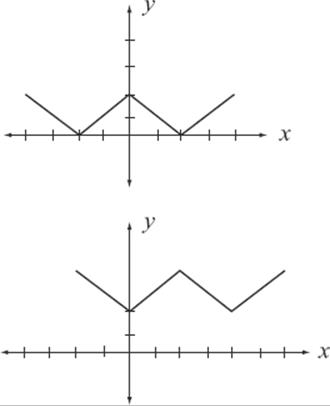
8. In the figure above, the graph on the top is the graph of y = f (x). Which of the following is the equation of the graph on the bottom?
(A) y = f (x + 2)
(B) y = f (x – 2)
(C) y = f (x + 2) + 2
(D) y = f (x – 2) + 2
(E) y = f (x + 2) – 2
Directions for Student-Produced Response Questions (Grid-ins)
In questions 9–18, first solve the problem, and then enter your answer on the grid provided on the answer sheet. The instructions for entering your answers are as follows:
• First, write your answer in the boxes at the top of the grid.
• Second, grid your answer in the columns below the boxes.
• Use the fraction bar in the first row or the decimal point in the second row to enter fractions and decimal answers.
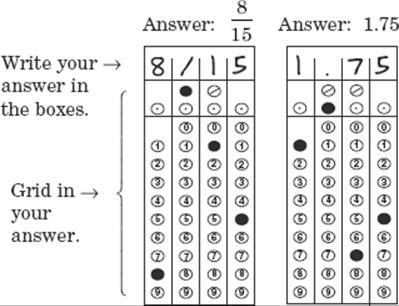
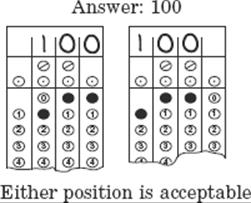
• Grid only one space in each column.
• Entering the answer in the boxes is recommended as an aid in gridding, but is not required.
• The machine scoring your exam can read only what you grid, so you must grid in your answers correctly to get credit.
• If a question has more than one correct answer, grid in only one of these answers.
• The grid does not have a minus sign, so no answer can be negative.
• A mixed number must be converted to an improper fraction or a decimal before it is gridded. Enter ![]() as 5/4 or 1.25; the machine will interpret 1 1/4 as
as 5/4 or 1.25; the machine will interpret 1 1/4 as ![]() and mark it wrong.
and mark it wrong.
• All decimals must be entered as accurately as possible. Here are the three acceptable ways of gridding
![]() = 0.272727....
= 0.272727....
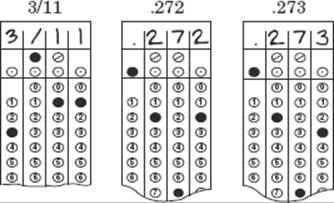
• Note that rounding to .273 is acceptable, because you are using the full grid, but you would receive no credit for .3 or .27, because these answers are less accurate.
9. What is the value of ![]() ?
?
10. If ab = 20 and a = –5, what is the value of a2 – b2?
11. If ![]() of x equals
of x equals ![]() of x, what is
of x, what is ![]() of x?
of x?
12. A clock chimes every hour to indicate the time, and also chimes once every 15 minutes on the quarter-hour and half-hour. For example, it chimes 3 times at 3:00, once at 3:15, once at 3:30, once at 3:45, and 4 times at 4:00. What is the smallest number of times the clock can chime in an interval of ![]() hours?
hours?
13. Each integer from 1 to 50 whose units digit is 7 is written on a separate slip of paper. If the slips are placed in a box and one is picked at random, what is the probability that the number picked is prime?
14. The average (arithmetic mean) amount of savings of 10 students is $60. If 3 of the students have no savings at all, and each of the others has at least $25, including John, who has exactly $130, what is the largest amount, in dollars, that any one student can have?
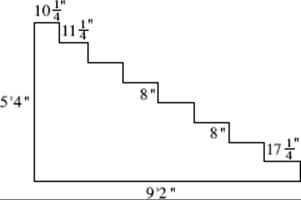
15. In the stair unit in the figure above, all the angles are right angles. The left side is 5 feet 4 inches, and the bottom is 9 feet 2 inches. Each vertical riser is 8 inches. The top step is 10.25 inches, and each step below it is 1 inch longer than the preceding step. What is the perimeter, in inches, of the figure?

16. In the figure above, what is the value of h?
17. Let a and b be positive numbers such that a% of a% of b equals c. If a2% of b equals kc, what is the value of k?
18. For how many positive three-digit numbers is the average of the three digits equal to 2?
S T O P
YOU MAY GO BACK AND REVIEW THIS SECTION IN THE REMAINING TIME, BUT DO NOT WORK IN ANY OTHER SECTION UNTIL TOLD TO DO SO.
SECTION 8
Time—20 Minutes 19 Questions
Select the best answer to each of the following questions; then blacken the appropriate space on your answer sheet.
Each of the following sentences contains one or two blanks; each blank indicates that a word or set of words has been left out. Below the sentence are five words or phrases, lettered A through E. Select the word or set of words that best completes the sentence.
Example:
Fame is ----; today’s rising star is all too soon tomorrow’s washed-up has-been.
(A) rewarding
(B) gradual
(C) essential
(D) spontaneous
(E) transitory
![]()
1. Given the ---- nature of wood, the oldest totem poles of the Northwest Coast Indians eventually fell to decay; only a few still stand today.
(A) resilient
(B) combustible
(C) malleable
(D) perishable
(E) solid
2. Lee, who refrained from excesses in his personal life, differed markedly from Grant, who ---- notorious drinking bouts with his cronies.
(A) deprecated
(B) minimized
(C) indulged in
(D) shunned
(E) compensated for
3. By nature Toshiro was ----, given to striking up casual conversations with strangers he encountered at bus stops or check-out stands.
(A) diffident
(B) observant
(C) reticent
(D) gregarious
(E) laconic
4. In the absence of native predators to stop their spread, imported deer ---- to such an inordinate degree that they overgrazed the countryside and ---- the native vegetation.
(A) thrived..threatened
(B) propagated..cultivated
(C) suffered..abandoned
(D) flourished..scrutinized
(E) dwindled..eliminated
5. The contract negotiations were often surprisingly ----, deteriorating at times into a welter of accusations and counteraccusations.
(A) perspicacious
(B) phlegmatic
(C) sedate
(D) acrimonious
(E) propitious
6. Black religion was in part a protest movement—a protest against a system and a society that was ---- designed to ---- the dignity of a segment of God’s creation.
(A) unintentionally..reflect
(B) explicitly..foster
(C) inevitably..assess
(D) deliberately..demean
(E) provocatively..enhance
The questions that follow the next two passages relate to the content of both, and to their relationship. The correct response may be stated outright in the passage or merely suggested.
Questions 7–19 are based on the following passages.
The following passages deal with the importance of money to Americans. The first is taken from a commencement address made by American philosopher George Santayana in 1904. The second is taken from an essay written by British poet W. H. Auden in 1963.
Passage 1
American life, everyone has heard, has extraordinary
intensity; it goes at a great rate. This is not
due, I should say, to any particular urgency in
the object pursued. Other nations have more
Line (5) pressing motives to bestir themselves than
America has: and it is observable that not all the
new nations, in either hemisphere, are energetic.
This energy can hardly spring either from unusually
intolerable conditions which people wish to
(10) overcome, nor from unusually important objects
which they wish to attain. It springs, I should
venture to say, from the harmony which subsists
between the task and the spirit, between the
mind’s vitality and the forms which, in America,
(15) political and industrial tradition has taken on. It is
sometimes said that the ruling passion in America
is the love of money. This seems to me a complete
mistake. The ruling passion is the love of
business, which is something quite different. The
(20) lover of money would be jealous of it; he would
spend it carefully; he would study to get out of it
the most he could. But the lover of business,
when he is successful, does not much change his
way of living; he does not think out what further
(25) advantages he can get out of his success. His joy
is in that business itself and in its further operation,
in making it greater and better organized and
a mightier engine in the general life. The adventitious
personal profit in it is the last thing he
(30) thinks of, the last thing he is skillful in bringing
about; and the same zeal and intensity is applied
in managing a college, or a public office, or a
naval establishment, as is lavished on private
business, for it is not a motive of personal gain
(35) that stimulates to such exertions. It is the absorbing,
satisfying character of the activities themselves;
it is the art, the happiness, the greatness of
them. So that in beginning life in such a society,
which has developed a native and vital tradition
(40) out of its practice, you have good reason to feel
that your spirit will be freed, that you will begin
to realize a part of what you are living for.
Passage 2
Political and technological developments are
rapidly obliterating all cultural differences and it
(45) is possible that, in a not remote future, it will be
impossible to distinguish human beings living on
one area of the earth’s surface from those living
on any other, but our different pasts have not yet
been completely erased and cultural differences
(50) are still perceptible. The most striking difference
between an American and a European is the
difference in their attitudes towards money. Every
European knows, as a matter of historical fact,
that, in Europe, wealth could only be acquired at
(55) the expense of other human beings, either by
conquering them or by exploiting their labor in
factories. Further, even after the Industrial Revolution
began, the number of persons who could rise from
poverty to wealth was small; the vast majority
(60) took it for granted that they would not be much
richer nor poorer than their fathers. In consequence,
no European associates wealth with personal
merit or poverty with personal failure.
To a European, money means power, the freedom
(65) to do as he likes, which also means that,
consciously or unconsciously, he says: “I want to
have as much money as possible myself and others
to have as little money as possible.”
In the United States, wealth was also acquired
(70) by stealing, but the real exploited victim was not
a human being but poor Mother Earth and her
creatures who were ruthlessly plundered. It is true
that the Indians were expropriated or exterminated,
but this was not, as it had always been in
(75) Europe, a matter of the conqueror seizing the
wealth of the conquered, for the Indian had never
realized the potential riches of his country. It is
also true that, in the Southern states, men lived on
the labor of slaves, but slave labor did not make
(80) them fortunes; what made slavery in the South all
the more inexcusable was that, in addition to
being morally wicked, it didn’t even pay off
handsomely.
Thanks to the natural resources of the country,
(85) every American, until quite recently, could
reasonably look forward to making more money than
his father, so that, if he made less, the fault must
be his; he was either lazy or inefficient. What an
American values, therefore, is not the possession
(90) of money as such, but his power to make it as a
proof of his manhood; once he has proved himself
by making it, it has served its function and can be
lost or given away. In no society in history have
rich men given away so large a part of their fortunes.
(95) A poor American feels guilty at being poor,
but less guilt than an American rentier* who has
inherited wealth but is doing nothing to increase
it; what can the latter do but take to drink and
psychoanalysis?
*A rentier lives on a fixed income from rents and investments.
7. In line 8, “spring” most nearly means
(A) leap
(B) arise
(C) extend
(D) break
(E) blossom
8. The lover of business (lines 22–38) can be described as all of the following EXCEPT
(A) enthusiastic
(B) engrossed
(C) enterprising
(D) industrious
(E) mercenary
9. The author of Passage 1 maintains that Americans find the prospect of improving business organizations
(A) pleasurable
(B) problematic
(C) implausible
(D) wearing
(E) unanticipated
10. In line 28, “engine” most nearly means
(A) artifice
(B) locomotive
(C) mechanical contrivance
(D) financial windfall
(E) driving force
11. The author of Passage 1 contends that those who grow up in American society will be influenced by its native traditions to
(A) fight the intolerable conditions afflicting their country
(B) achieve spiritual harmony through meditation
(C) find self-fulfillment through their business activities
(D) acknowledge the importance of financial accountability
(E) conserve the country’s natural resources
12. In lines 43–48 the author of Passage 2 asserts that technological advances
(A) are likely to promote greater divisions between the rich and the poor
(B) may eventually lead to worldwide cultural uniformity
(C) can enable us to tolerate any cultural differences between us
(D) may make the distinctions between people increasingly easy to discern
(E) destroy the cultural differences they are intended to foster
13. In line 50, “striking” most nearly means
(A) attractive
(B) marked
(C) shocking
(D) protesting
(E) commanding
14. In taking it for granted that they will not be much richer or poorer than their fathers (lines 59–61), Europeans do which of the following?
(A) They express a preference.
(B) They refute an argument.
(C) They qualify an assertion.
(D) They correct a misapprehension.
(E) They make an assumption.
15. Until quite recently, according to lines 84–88, to Americans the failure to surpass one’s father in income indicated
(A) a dislike of inherited wealth
(B) a lack of proper application on one’s part
(C) a fear of the burdens inherent in success
(D) the height of fiscal irresponsibility
(E) the effects of a guilty conscience
16. The author’s description of the likely fate of the American rentier living on inherited wealth is
(A) astonished
(B) indulgent
(C) sorrowful
(D) sympathetic
(E) ironic
17. In Passage 2 the author does all of the following EXCEPT
(A) make a categorical statement
(B) correct a misapprehension
(C) draw a contrast
(D) pose a question
(E) cite an authority
18. The authors of both passages most likely would agree that Americans engage in business
(A) on wholly altruistic grounds
(B) as a test of their earning capacity
(C) only out of economic necessity
(D) regardless of the example set by their parents
(E) for psychological rather than financial reasons
19. Compared to the attitude toward Americans expressed in Passage 1, the attitude toward them expressed in Passage 2 is
(A) more admiring
(B) less disapproving
(C) more cynical
(D) less patronizing
(E) more chauvinistic
S T O P
YOU MAY GO BACK AND REVIEW THIS SECTION IN THE REMAINING TIME, BUT DO NOT WORK IN ANY OTHER SECTION UNTIL TOLD TO DO SO.
SECTION 9
Time—20 Minutes 16 Questions
For each problem in this section determine which of the five choices is correct and blacken the corresponding choice on your answer sheet. You may use any blank space on the page for your work.
Notes:
• You may use a calculator whenever you think it will be helpful.
• Only real numbers are used. No question or answer on this test involves a complex or imaginary number.
• Use the diagrams provided to help you solve the problems. Unless you see the words “Note: Figure not drawn to scale” under a diagram, it has been drawn as accurately as possible. Unless it is stated that a figure is three-dimensional, you may assume it lies in a plane.
• For any function f, the domain, unless specifically restricted, is the set of all real numbers for which f (x) is also a real number.
Reference Information


1. If a = –2, what is the value of a4 – a3 + a2 – a?
(A) –30
(B) –10
(C) 0
(D) 10
(E) 30
2. If a mixture of nuts consists of 3 pounds of peanuts, 1 pound of walnuts, and 5 pounds of cashews, by weight, what fraction of the mixture is peanuts?
(A) ![]()
(B) ![]()
(C) ![]()
(D) ![]()
(E) ![]()
3. When a digital clock reads 3:47, the sum of the digits is 14. How many minutes after 3:47 will the sum of the digits be 20 for the first time?
(A) 42
(B) 132
(C) 192
(D) 251
(E) 301
4. Let f(x) = ![]() What is the smallest integer for which f(x) is defined?
What is the smallest integer for which f(x) is defined?
(A) 0
(B) 1
(C) 3
(D) 4
(E) 5
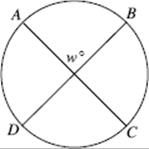
AC and BD are diameters.
Note: Figure not drawn to scale
5. In the figure above, if w = 40, what is the ratio of the total length of arcs ![]() and
and ![]() to the circumference?
to the circumference?
(A) ![]()
(B) ![]()
(C) ![]()
(D) ![]()
(E) ![]()
6. Phil’s Phone Shop sells three models of cellular phones, priced at $100, $125, and $225. In January, Phil sold exactly the same number of each model. What percent of the total income from the sales of cellular phones was attributable to sales of the cheapest model?
(A) ![]()
(B) ![]()
(C) ![]()
(D) ![]()
(E) It cannot be determined from the information given.
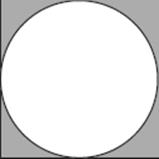
7. In the figure above, a circle is inscribed in a square. If a point is chosen at random inside the square, which of the following is closest to the probability that the point is in the shaded region?
(A) 0.1
(B) 0.15
(C) 0.2
(D) 0.25
(E) 0.3
8. Gilda drove 650 miles at an average speed of 50 miles per hour. How many miles per hour faster would she have had to drive in order for the trip to have taken 1 hour less?
(A) ![]()
(B) ![]()
(C) ![]()
(D) ![]()
(E) ![]()
9. If a team played g games and won w of them, what fraction of the games played did the team lose?
(A) ![]()
(B) ![]()
(C) ![]()
(D) ![]()
(E) ![]()
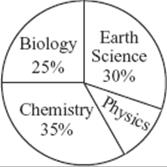
10. The chart above shows the percent of students at Central High School taking each of the four science courses offered. If every student takes exactly one science course, and if 20% of the students taking chemistry switch to physics, what percent of the students will be taking physics?
(A) 7%
(B) 17%
(C) 20%
(D) 25%
(E) 30%
11. In 2000, the cost of p pounds of potatoes was d dollars. In 2010, the cost of 2p pounds of potatoes was ![]() d dollars. By what percent did the price of potatoes decrease from 2000 to 2010?
d dollars. By what percent did the price of potatoes decrease from 2000 to 2010?
(A) 25%
(B) 50%
(C) 75%
(D) 100%
(E) 400%
12. If a square and an equilateral triangle have equal perimeters, what is the ratio of the area of the triangle to the area of the square?
(A) ![]()
(B) ![]()
(C) ![]()
(D) ![]()
(E) ![]()
13. If A is at (3, –1) and B is at (5, 6), what is the slope of the perpendicular bisector of segment AB?
(A) ![]()
(B) ![]()
(C) ![]()
(D) ![]()
(E) ![]()
14. In the sequence 1, 2, 3, –4, 1, 2, 3, –4, …, the numbers 1, 2, 3, –4 repeat indefinitely. What is the sum of the first 150 terms?
(A) 0
(B) 3
(C) 37
(D) 77
(E) 300
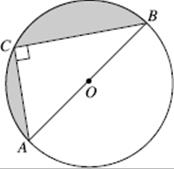
15. In the figure above, AB is a diameter of circle O. If AC = 6 and the radius of the circle is 5, what is the perimeter of the shaded region?
(A) 14 + 5π
(B) 17 + 5π
(C) 14 + 10π
(D) 17 + 10π
(E) 24 + 5π
16. If the sum of all the positive even integers less than 1000 is A, what is the sum of all the positive odd integers less than 1000?
(A) A – 998
(B) A – 499
(C) A + 1
(D) A + 500
(E) ![]() + 999
+ 999
S T O P
YOU MAY GO BACK AND REVIEW THIS SECTION IN THE REMAINING TIME, BUT DO NOT WORK IN ANY OTHER SECTION UNTIL TOLD TO DO SO.
SECTION 10
Time—10 Minutes 14 Questions
For each of the following questions, select the best answer from the choices provided and fill in the appropriate circle on the answer sheet.
Some or all parts of the following sentences are underlined. The first answer choice, (A), simply repeats the underlined part of the sentence. The other four choices present four alternative ways to phrase the underlined part. Select the answer that produces the most effective sentence, one that is clear and exact, and blacken the appropriate space on your answer sheet. In selecting your choice, be sure that it is standard written English, and that it expresses the meaning of the original sentence.
Example:
The first biography of author Eudora Welty came out in 1998 and she was 89 years old at the time.
(A) and she was 89 years old at the time
(B) at the time when she was 89
(C) upon becoming an 89 year old
(D) when she was 89
(E) at the age of 89 years old
![]()
1. Experts predict that global warming will cause sea levels to raise and lead to flooding from tidal surges.
(A) will cause sea levels to raise and lead to flooding
(B) would cause sea levels to raise and lead to flooding
(C) will result in raising sea levels and leading to floods
(D) will be the cause of sea levels’ rising and flooding
(E) will raise sea levels and lead to flooding
2. When one realizes how very different caterpillars and spiders are, you too will find it remarkable that they produce silks that are similar.
(A) When one realizes how very different caterpillars and spiders are
(B) If one should realize the great differences between caterpillars and spiders
(C) If one realizes how greatly caterpillars and spiders differ
(D) When you realize how very different caterpillars and spiders are
(E) Upon the realization of how very different caterpillars and spiders are
3. The della Robbias created many sculptural reliefs of the Virgin and Child surrounded by garlands, and they traditionally worked in terra-cotta.
(A) The della Robbias created many sculptural reliefs of the Virgin and Child surrounded by garlands, and they
(B) The della Robbias, who created many sculptural reliefs of the Virgin and Child surrounded by garlands,
(C) Creating many sculptural reliefs of the Virgin and Child surrounded by garlands were the della Robbias, and they
(D) The della Robbias created many sculptural reliefs of the Virgin and Child surrounded by garlands, and doing this they
(E) In the creation of many sculptural reliefs of the Virgin and Child surrounded by garlands, the della Robbias they
4. An egotist is when a person thinks the entire universe revolves around him or her.
(A) An egotist is when a person thinks the entire universe revolves around him or her.
(B) Egotists think the entire universe revolves around them.
(C) An egotist is when a person thinks the entire universe is revolving around them.
(D) An egotist is a person which thinks the entire universe revolves around him or her.
(E) An egotistical person thinks the entire universe revolves around himself or herself.
5. Harold Brodkey’s eager anticipated first novel was so long in coming—more than three decades, as it turned out—that he actually became famous for not writing a book.
(A) Brodkey’s eager anticipated first novel was so long in coming
(B) Brodkey’s eager anticipated first novel took so long to come
(C) Brodkey eagerly anticipated his first novel, it was so long in coming
(D) Brodkey eagerly anticipated his first novel, and it took so long to come
(E) Brodkey’s eagerly anticipated first novel was so long in coming
6. Studies demonstrate the beneficial effects of keeping pets, many senior housing centers are adopting strays from local humane societies.
(A) Studies demonstrate the beneficial effects of keeping pets, many
(B) Though studies demonstrate the beneficial effects from keeping pets, many
(C) Because studies demonstrate the beneficial effects of keeping pets, many
(D) Studies demonstrate the beneficial effects of keeping pets, and many
(E) Studies demonstrate that there are beneficial effects from keeping pets, therefore many
7. Having excelled in football, baseball, as well as track, Jim Thorpe is hailed by many as the greatest athlete of the twentieth century.
(A) Having excelled in football, baseball, as well as track
(B) With his excellence in football and baseball and being a track star
(C) Because he excelled in football, baseball, and track
(D) Having excelled in football and baseball, what is more, track
(E) By being excellent in football and baseball and also track
8. Running an insurance agency left Charles Ives little time for composition, yet he nevertheless developed a unique musical idiom.
(A) nevertheless developed a unique musical idiom
(B) nevertheless developed a very unique musical idiom
(C) therefore developed a uniquely musical idiom
(D) nevertheless developed his musical idiom uniquely
(E) however developed a very unique and idiomatic music
9. While some scientists are absorbed by the philosophical question of what consciousness is, but others restrict themselves to trying to understand what is going on at the neurological level when consciousness is present.
(A) While some scientists are absorbed by the philosophical question of what consciousness is,
(B) Although some scientists are absorbed by the philosophical question of what consciousness is,
(C) Some scientists are absorbed by the philosophical question of what consciousness is,
(D) Some scientists being absorbed by the philosophical question of what consciousness is,
(E) While some scientists absorbed the philosophical question of what consciousness is,
10. Given the difficulties inherent in bringing up children, it is remarkable that so many single parents succeed in raising happy, healthy youngsters
(A) Given the difficulties inherent in bringing up children, it is remarkable that
(B) Given the difficulties inherent in bringing up children, it seems remarkably that
(C) If you give the difficulties inherent and bring up children, it is remarkable that
(D) Giving the difficulties inherent in the upbringing of children, they are remarkable in that
(E) Having been given the difficulties inherent in bringing up children, one is able to remark that
11. Music journalism at its highest level is a valid literary genre, not a vicarious alternative to mastering an instrument.
(A) genre, not a
(B) genre, it is not a
(C) genre; not a
(D) genre, but is not a
(E) genre; and it is not a
12. Although his fantasy trilogy, The Lord of the Rings, was far better known than his linguistic research on Anglo-Saxon verse, Professor Tolkien refused to grant interviews about the novels he had written or otherwise to promotehis nonacademic work.
(A) had written or otherwise to promote
(B) had written or otherwise promoting
(C) wrote nor otherwise promoting
(D) has written nor otherwise to have promoted
(E) wrote or otherwise promoting
13. Many of us attempt to rewrite our personal stories to present ourselves in the best light; indeed, there is an almost universal inclination to this.
(A) there is an almost universal inclination to this
(B) our inclination for it is almost universal
(C) our having this inclination is an almost universal condition
(D) we are almost universally inclined to do so
(E) doing so is almost universal as an inclination within us
14. The best known Iban textiles, large ceremonial cloths called pua kumbu, whose designs depict the flora and fauna of Borneo as well as figures from the spirit realm.
(A) textiles, large ceremonial cloths called pua kumbu, whose designs depict
(B) textiles, large ceremonial cloths called pua kumbu, in whose designs are depicted
(C) textiles are large ceremonial cloths called pua kumbu, whose designs depict
(D) textiles are large ceremonial cloths called pua kumbu, their designs depict
(E) textiles, large ceremonial cloths, are called puakumbu, in their designs are depicted
S T O P
YOU MAY GO BACK AND REVIEW THIS SECTION IN THE REMAINING TIME, BUT DO NOT WORK IN ANY OTHER SECTION UNTIL TOLD TO DO SO.
Answer Key
Note: The letters in brackets following the Mathematical Reasoning answers refer to the sections of Chapter 9 in which you can find the information you need to answer the questions. For example, 1. C [E] means that the answer to question 1 is C, and that the solution requires information found in Section 9-E: Averages.
Section 2 Critical Reading
|
1. C 2. E 3. A 4. B 5. C 6. C 7. D 8. C |
9. A 10. A 11. A 12. D 13. B 14. E 15. E 16. D |
17. E 18. D 19. D 20. D 21. C 22. D 23. B 24. A |
Section 3 Mathematical Reasoning
|
1. E [G] 2. E [C] 3. B [A, E] 4. A [J] 5. C [D, H] 6. B [I, D] 7. B [J, K] |
8. B [E] 9. A [J] 10. D [J] 11. D [A] 12. C [G] 13. C [I, J] 14. B [E] |
15. C [R] 16. A [D] 17. C [L, N] 18. C [E] 19. C [G] 20. D [K, L] |
Section 4 Writing Skills
|
1. A 2. E 3. C 4. A 5. D 6. C 7. E 8. C 9. D 10. B 11. A 12. D |
13. E 14. D 15. E 16. D 17. D 18. C 19. A 20. D 21. D 22. C 23. C 24. D |
25. C 26. D 27. A 28. C 29. E 30. D 31. D 32. B 33. A 34. E 35. C |
Section 5
On this test, Section 5 was the experimental section. It could have been an extra critical reading, mathematics, or writing skills section. Remember: on the SAT you take, the experimental section may be any section from 2 to 7.
Section 6 Critical Reading
|
1. C 2. B 3. E 4. A 5. C 6. C 7. D 8. E |
9. C 10. C 11. E 12. D 13. D 14. D 15. D 16. D |
17. C 18. B 19. E 20. D 21. B 22. D 23. E 24. C |
Section 7 Mathematical Reasoning
Multiple-Choice Questions
|
1. A [K] 2. D [D] 3. C [F] |
4. B [M] 5. E [A, G] 6. C [L, O] |
7. B [K, N] 8. D [R] |
Grid-in Questions
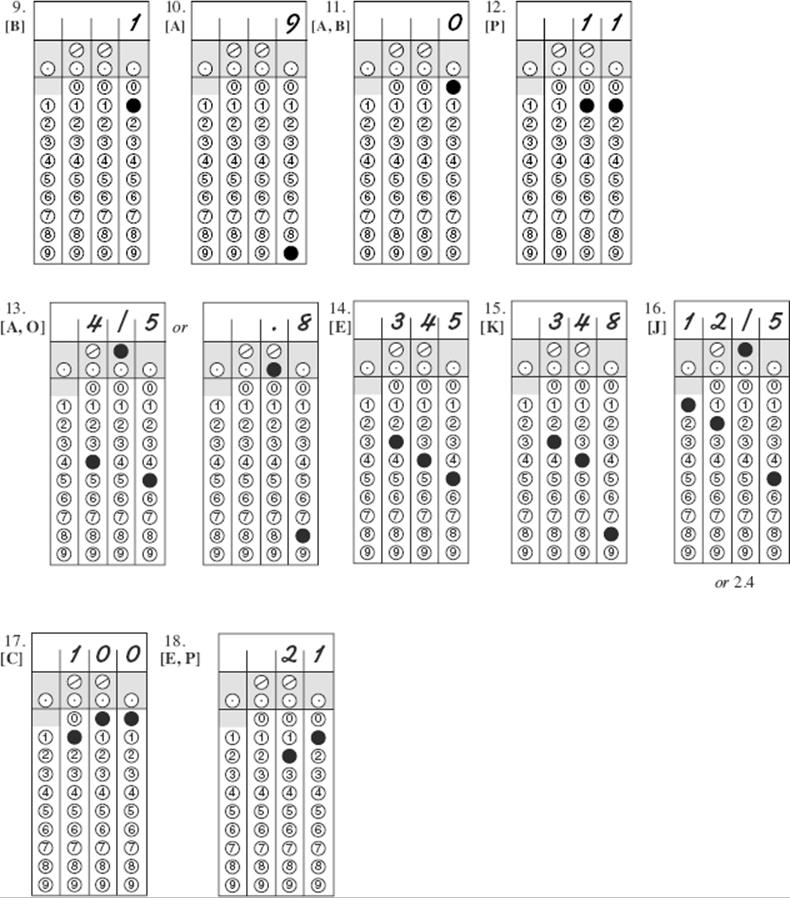
Section 8 Critical Reading
|
1. D 2. C 3. D 4. A 5. D 6. D 7. B |
8. E 9. A 10. E 11. C 12. B 13. B 14. E |
15. B 16. E 17. E 18. E 19. C |
Section 9 Mathematical Reasoning
|
1. E [A] 2. C [B] 3. C [P] 4. E [R] 5. B [L] 6. A [C] |
7. C [K, L, O] 8. D [M] 9. C [B] 10. B [C, Q] 11. C [C, D] 12. A [J, K] |
13. C [N] 14. D [P] 15. A [J, L] 16. D [A, P] |
Section 10 Writing Skills
|
1. E 2. D 3. B 4. B 5. E |
6. C 7. C 8. A 9. C 10. A |
11. A 12. A 13. D 14. C |
Score Your Own SAT Essay
Use this table as you rate your performance on the essay-writing section of this Model Test. Circle the phrase that most accurately describes your work. Enter the numbers in the scoring chart below. Add the numbers together and divide by 6 to determine your total score. The higher your total score, the better you are likely to do on the essay section of the SAT.
Note that on the actual SAT two readers will rate your essay; your essay score will be the sum of their two ratings and could range from 12 (highest) to 2 (lowest). Also, they will grade your essay holistically, rating it on the basis of their overall impression of its effectiveness. They will not analyze it piece by piece, giving separate grades for grammar, vocabulary level, and so on. Therefore, you cannot expect the score you give yourself on this Model Test to predict your eventual score on the SAT with any great degree of accuracy. Use this scoring guide instead to help you assess your writing strengths and weaknesses, so that you can decide which areas to focus on as you prepare for the SAT.
Like most people, you may find it difficult to rate your own writing objectively. Ask a teacher or fellow student to score your essay as well. With his or her help you should gain added insights into writing your 25-minute essay.

|
Self-Scoring Chart |
Scoring Chart (Second Reader) |
||
|
For each of the following categories, rate the essay from 1 (lowest) to 6 (highest) |
For each of the following categories, rate the essay from 1 (lowest) to 6 (highest) |
||
|
Position on the Topic |
|
Position on the Topic |
|
|
Organization of Evidence |
|
Organization of Evidence |
|
|
Sentence Structure |
|
Sentence Structure |
|
|
Level of Vocabulary |
|
Level of vocabulary |
|
|
Grammar and Usage |
|
Grammar and Usage |
|
|
Overall Effect |
|
Over Effect |
|
|
TOTAL |
|
TOTAL |
|
|
(To get a score, divide the total by 6) |
|
(To get a score, divide the total by 6) |
|
Calculate Your Raw Score
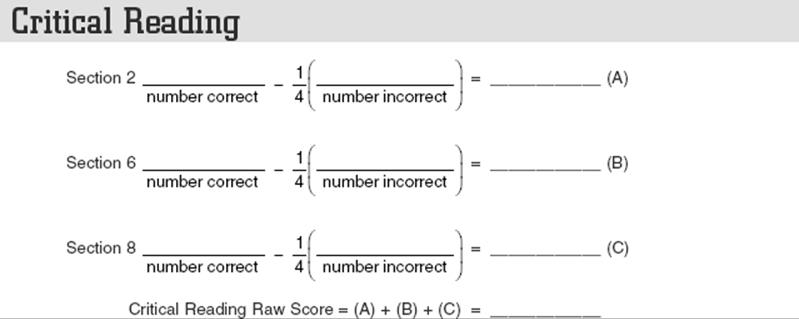
Mathematical Reasoning
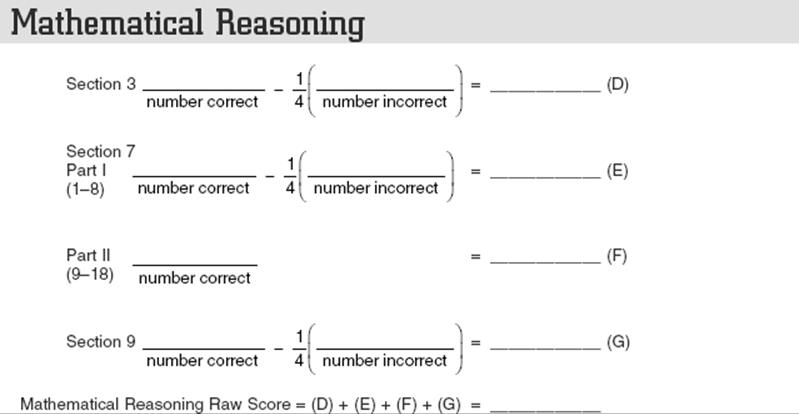
Writing Skills
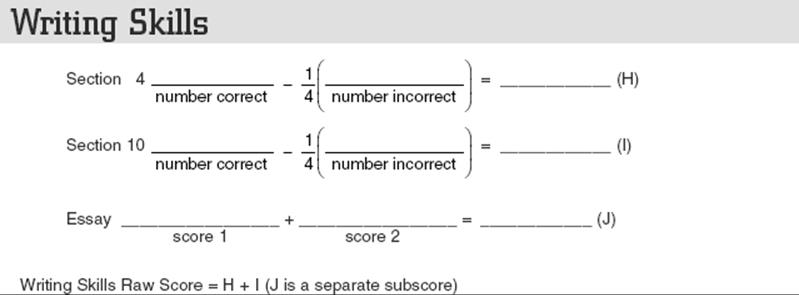
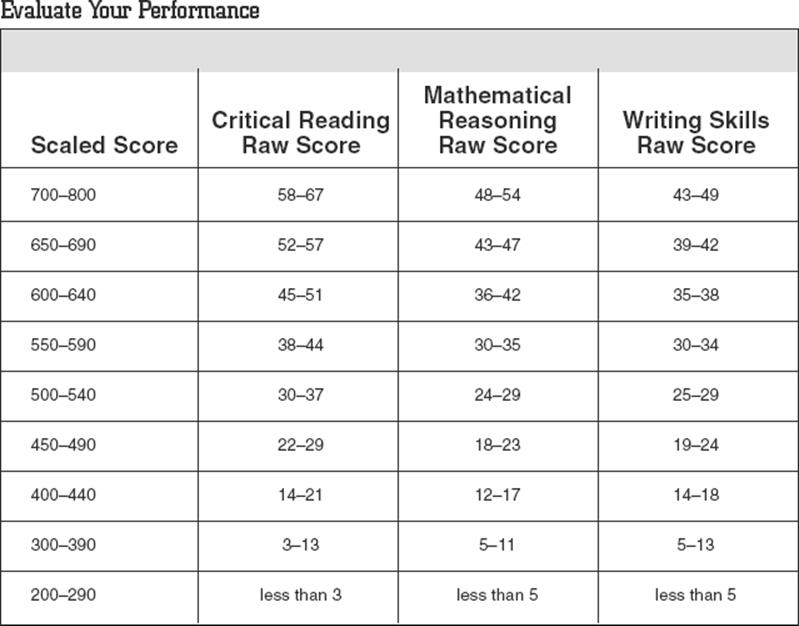
Identify Your Weaknesses
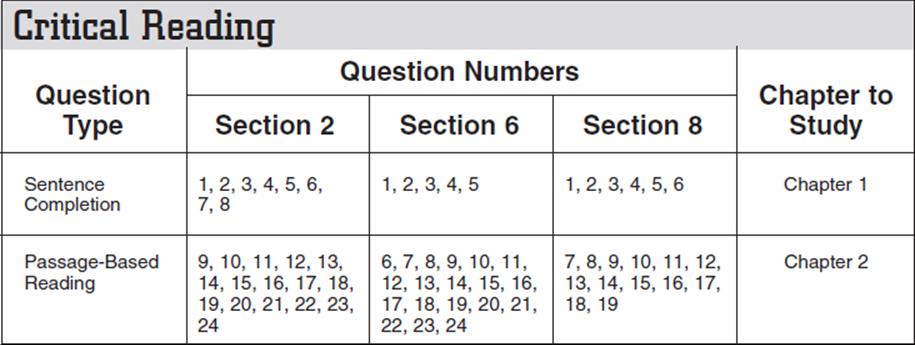
Identify Your Weaknesses
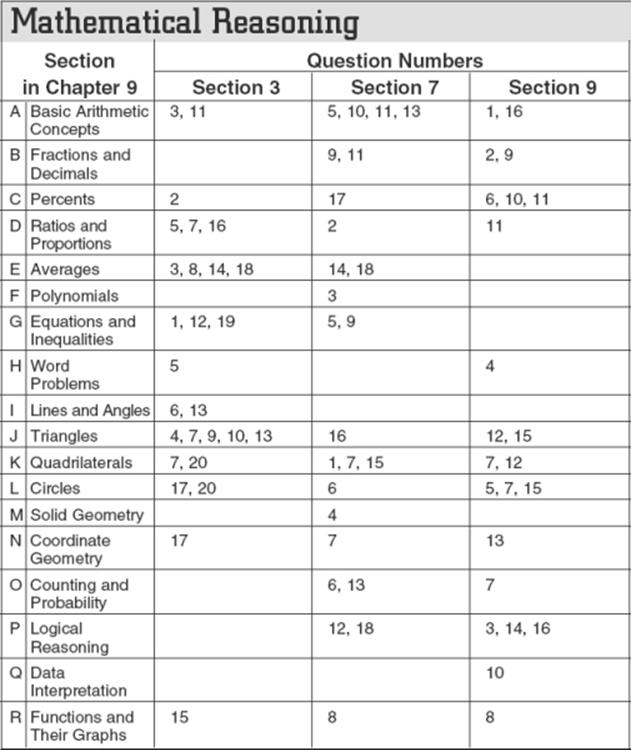
Identify Your Weaknesses
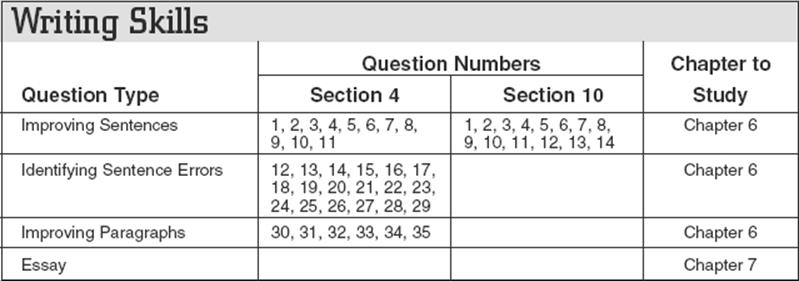
ANSWERS EXPLAINED
Section 2 Critical Reading
1. C. The reviewer was vitriolic (as biting as acid), devastating (destructive), and irritating (annoying). He was not constructive or helpful.
Never signals a contrast. The missing word must be an antonym or near-antonym for the three adjectives in the series.
Note that you are looking for a word with positive associations. Therefore, you can eliminate any word with negative ones. Choices D and E have negative associations. Only Choice A, B, or C can be correct. Choice C is preferable.
(Contrast Signal)
2. E. The team members tolerated or put up with the coach’s rules as long as the coach was not too strict in applying them.
Despite signals a contrast. You expect people who resent rules to fight them or disobey them.
Instead, the team members put up with them.
Remember: in double-blank sentences, go through the answer choices, testing the first word in each choice and eliminating the ones that don’t fit. You can immediately eliminate Choices B, C, and D.
(Contrast Signal)
3. A. If we still cannot make up our minds whether low-level microwave radiation is dangerous or safe, our evidence must be too weak for us to be able to decide; it must be inconclusive.
Remember: before you look at the choices, read the sentence and think of a word that makes sense.
Likely Words: incomplete, uncorroborated, unverified.
(Argument Pattern)
4. B. Tacitus’ descriptions were limited or hindered by the crude (primitive) state of communications. But signals a contrast. The fact that Tacitus’ descriptions match those of other writers of his time implies that they are reasonable descriptions for that period. They are adequate in spite of the limitations they suffered from.
(Contrast Signal)
5. C. If future archaeological discoveries will be “hard put to match” the revelations of the past ten years, the past decade’s discoveries must have been truly remarkable ones, ones that radically or fundamentally changed the field.
Even striking or dramatic discoveries could not compare with such revelations.
(Argument Pattern)
6. C. Indian art recalls (is reminiscent of) Japanese art because, like Japanese art, it minimizes; it understates.
The clause following “Japanese art” gives examples of what Japanese art is like: it suggests; it does not state directly or overstate.
Look at the first word of each answer pair. If the first word means states directly or overstates, then the second word must mean “is unlike,” because it is unlike Japanese art to overstate. If the first word means suggests or understates, then the second word must mean “is like,” because it is like Japanese art to understate.
(Examples)
7. D. If irony has become a way of escape, then its job is to help people escape or evade life’s terrors.
Note that the second clause defines what is meant by irony as a mode of escape. It clarifies the phrase’s meaning.
(Definition)
8. C. Looking down on the demonstrators (viewing them with “little respect”), the police would most likely talk about them in pejorative (negative) terms.
(Definition)
9. A. By denying the existence of a love affair between Pocahontas and John Smith, the author is debunking (exposing the falseness of) a common myth.
10. A. By saying “True,” the author admits that there was some sort of relationship between Pocahontas and John Smith, even if it was not the passionate relationship that lovers of romantic tales would prefer.
11. A. To say that today’s chocolate lovers would not find the Aztec’s “food of the gods” heavenly is a humorous understatement. More likely, their reaction would be like that of the Spanish explorers who described the unsweetened chocolate beverage as food for pigs!
12. D. In describing the Aztec beverage as “fitter for hogs than men,” the explorers were being scornful or derisive.
13. B. The author describes his rapture or great joy when he first saw his new owner’s smiling face. Clearly, his immediate response to the prospect of living with the Aulds was chiefly one of marked (distinct) pleasure.
14. E. Lines 21–24 state that “by constant application to her business, she [Mrs. Auld] had been in a good degree preserved from the blighting and dehumanizing effects of slavery.” Mrs. Auld has applied herself to her business or trade of weaving. She has concentrated on this trade. Because she has not owned slaves but has kept herself busy with her own work, she has been relatively unaffected by slavery and has not adopted the inhumane attitudes typical of slave owners.
15. E. The sentences immediately following Douglass’s comment about his early instruction clarify what he had been taught. He had been taught to behave in a slavish, obsequious fashion. However, “her favor was not gained by it [crouching servility]; she seemed to be disturbed by it” (lines 29 and 30). In other words, the obsequiousness in which Douglass had been drilled distressed his new mistress.
16. D. Fawning and cringing did not serve the purpose of pleasing Mrs. Auld; such slavish behavior did not do at all in this particular situation.
17. E. According to Douglass, at the time he met her Mrs. Auld was a kind, loving woman who had not yet had the experience of owning slaves.
Thus, she had been kept free of “the blighting and dehumanizing effects of slavery” (lines 23 and 24). However, she now owned a slave— Douglass himself—and would inevitably be affected by her power over him. Her kind heart would cease to be kind: she was destined to undergo a change of character as she became corrupted by her participation in the institution of slavery.
18. D. The passage does not suggest that a disdain (scorn) for convention is typical of Mrs. Auld. Therefore, Choice D is correct.
Mrs. Auld was noted for “constant application to her business” (lines 21 and 22). This implies that diligence in labor was one of her characteristics. Therefore, Choice A is incorrect. Mrs. Auld seemed “disturbed” by “crouching servility” (lines 26 and 27). This implies that a dislike of fawning was one of her characteristics. Therefore, Choice B is incorrect.
Mrs. Auld was kindhearted (lines 16 and 17) and able to put people at ease (lines 32 and 33). This implies that gentleness of spirit was one of her characteristics. Therefore, Choice C is incorrect.
Mrs. Auld voluntarily began to teach the narrator. She wished him well. This implies that a benevolent nature was one of her characteristics. Therefore, Choice E is incorrect.
19. D. Choice D is correct. You can arrive at it by the process of elimination.
Statement I is true. In line 45 Mr. Auld tells his wife that instructing slaves is unlawful: it violates the law. Therefore, you can eliminate Choice B.
Statement II is untrue. Since Mr. Auld is so concerned that education would spoil his slaves, he must believe that slaves can be taught. Therefore, you can eliminate Choices C and E.
Statement III is true. Mr. Auld states that a slave who was able to read would become “unmanageable” (line 54). Therefore, you can eliminate Choice A.
Only Choice D is left. It is the correct answer.
20. D. Mr. Auld is arguing that Mrs. Auld should not give Douglass reading lessons. To convince her, he cites a variant of the proverb “If you give him an inch, he’ll take a mile.”
(In other words, he’ll take a lot more than you originally planned to give him.) A mile is a much larger unit of length than an inch.
We can assume that an ell is a much larger unit of length than an inch, also.
21. C. The author’s purpose in this passage is to show how he discovered that learning to read was vital for him if he wanted to be free. The bulk of the passage deals with learning to read—the author’s introduction to it, his master’s arguments against it, his own increased determination to succeed in it.
Choice A is incorrect. It is the cause of the disagreement that is central, not the existence of the disagreement.
Choice B is incorrect. The author lists, but does not analyze, the master’s reasons for forbidding his wife to teach her slave.
Choice D is incorrect. It is unsupported by the passage.
Choice E may seem a possible answer, but it is too narrow in scope. Only the last two sentences of the first paragraph stress Mrs. Auld’s moral downfall.
22. D. Douglass states that his master “was deeply sensible of the truths he was uttering.” In other words, his master was highly conscious that he was saying the truth; he felt sure that only evil consequences would come from teaching a slave to read.
23. B. The author’s tone is strongly ironic. He knows full well that, in opposing his education, his master did not intend to benefit him. Thus, by acknowledging his “debt” to his master, the author is underlining his master’s defeat. His tone is cutting and ironic.
Choice A is incorrect. The author is not filled with loving sentiment and warmth when he thinks of his harsh master.
Choice C is incorrect. The author neither whines nor congratulates himself on his own moral superiority.
Choice D is incorrect. The author is not resigned or submissive; he certainly is not wistful or longing for the days gone by.
Choice E is incorrect. Although the author still feels anger at the institution of slavery, when he thinks of his master’s defeat he feels triumphant as well.
24. A. The author wholly believes his master’s statement that learning would make him unmanageable. In other words, education would make him impossible to enslave.
Choice B is incorrect. The author is concerned with education for freedom, not for old age.
Choices C, D, and E are incorrect. They are unsupported by the passage.
Section 3 Mathematical Reasoning
In each mathematics section, for many problems, an alternative solution, indicated by two asterisks (**), follows the first solution. When this occurs, one of the solutions is the direct mathematical one and the other is based on one of the tactics discussed in Chapter 8 and 9.
1. E. a – 5 = 0 ![]() a = 5
a = 5 ![]() a + 5 = 10.
a + 5 = 10.
2. E. Use your calculator only if you don’t realize that 50% = ![]() . Otherwise, just say
. Otherwise, just say ![]() of 50 is 25, and
of 50 is 25, and ![]() of 25 is 12.5.
of 25 is 12.5.
3. B. The average of x and y is ![]() , and the product of that fraction and 5 is
, and the product of that fraction and 5 is ![]()
**It’s easier and quicker to do this directly, so substitute for x and y only if you get stuck or confused. If x = 2 and y = 4, their average is 3; and the product of 5 and 3 is 15. Only ![]() is equal to 15 when x = 2 and y = 4.
is equal to 15 when x = 2 and y = 4.
4. A. Since x + 100 = 180, x = 80 and 2x = 160. Then, 180 = y + 2x = y + 160, and so y = 20.
5. C. ![]() In 1 minute light will travel
In 1 minute light will travel
(300,000 km/s)(60 s) = 18,000,000 km.
Therefore, light will travel 150,000,000 kilometers in ![]() minutes.
minutes.
**Since 150,000,000 km ÷ 300,000 km/s = 500 s, it takes 500 seconds for light to travel from the sun to Earth. Finally, 500 seconds = ![]() minute.
minute.
6. B. Every hour the hour hand moves through 30° ![]() It will move through 10° in
It will move through 10° in ![]() hour, or 20 minutes; and 20 minutes after 1:15 the time is 1:35.
hour, or 20 minutes; and 20 minutes after 1:15 the time is 1:35.
7. B. Draw a square, and let the sides be 1. Then, by KEY FACTS J8 and J10, the diagonal, d, is ![]() , and d 2= 2. Since the area of the square is 1, d2 is twice the area of the square.
, and d 2= 2. Since the area of the square is 1, d2 is twice the area of the square.
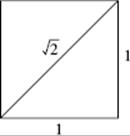
**By KEY FACT K8, one formula for the area of a square is A = ![]() .
.
8. B. Since the average of a, b, c, and d is 10, their sum is 40. The only other condition is that they be in increasing order. The numbers could be 1, 2, 3, and 34, in which case both I and III are false. This guarantees that the answer is II only. In fact, II is true: in any set of numbers that are not all equal, the smallest number in the set is less than the average of the numbers, and the greatest number is more than their average.
9. A. Use TACTIC 1: draw a diagram, and label all the line segments.
Now add two segments to create a right triangle. Since the legs are 6 and 8, the hypotenuse is 10.
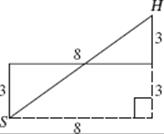
**Use TACTIC 8: eliminate the absurd choices and guess. The woman rode 14 miles.
Clearly, the direct path is shorter; eliminate C, D, and E. Since it’s probably much shorter, eliminate B, as well.
10. D. There are only two possibilities. Either (i) 5 and 6 are the lengths of the two legs, or (ii) 5 is the length of a leg, and 6 is the hypotenuse. In either case use the Pythagorean theorem:
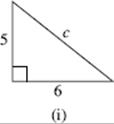
(i) 52 + 62 = c2 ![]()
c2 = 61 ![]() c =
c = ![]()
or
(ii) a2 + 52 = 62![]() a2 = 36 – 25 = 11
a2 = 36 – 25 = 11![]()
a =![]()

Statements I and II only are true.
11. D. By definition, ![]() =
=
(5)(3)(2) – (5 + 3 + 2) = 30 – 10 = 20.
12. C. Check each choice to see which of the equations has (have) exactly one positive integer solution.
I. For every number a: (0)(a)(–a) = 0 and 0 + a + (–a) = 0, so for every positive integer a, ![]() = 0 – 0 = 0. (I is false)
= 0 – 0 = 0. (I is false)
II. ![]() = a · a · a – (a + a + a) = a3 – 3a = a(a2 – 3).
= a · a · a – (a + a + a) = a3 – 3a = a(a2 – 3).
So, if ![]() = 0, then a = 0 or a2 – 3 = 0, in which case a = ±
= 0, then a = 0 or a2 – 3 = 0, in which case a = ±![]() , none of which is a positive integer.
, none of which is a positive integer.
III ![]() = a · 2a · 3a – (a + 2a + 3a) = 6a3 – 6a = 6a(a2 – 1).
= a · 2a · 3a – (a + 2a + 3a) = 6a3 – 6a = 6a(a2 – 1).
So, if ![]() = 0, then a = 0 or a2 = 1 = 0, in which case a = 1 or a = –1. So, this equation has one positive integer solution, a = 1. (III is true.)
= 0, then a = 0 or a2 = 1 = 0, in which case a = 1 or a = –1. So, this equation has one positive integer solution, a = 1. (III is true.)
Statement III only is true.
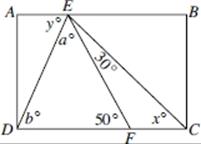
13. C. There are many ways to get the values of x and y; here’s the easiest.
Since ![]() EFD is an exterior angle of
EFD is an exterior angle of ![]() FEC, 50 = 30 + x
FEC, 50 = 30 + x ![]() x = 20 (KEY FACT J2). Since in
x = 20 (KEY FACT J2). Since in ![]() DEF, DF = EF, then a = b and
DEF, DF = EF, then a = b and
a + b + 50 = 180 ⇒ a + b = 130,
so a and b are 65 each. But since the opposite sides of a rectangle are parallel, b = y, so y = 65 and x + y = 20 + 65 = 85.
14. B. ![]() It’s possible to reason the answer out without writing down and adding up all the numbers, but it won’t save any time. Systematically list them: 123, 132, 213, 231, 312, 321. Use your calculator: the sum is 1332, and the average is 1332 ÷ 6 = 222.
It’s possible to reason the answer out without writing down and adding up all the numbers, but it won’t save any time. Systematically list them: 123, 132, 213, 231, 312, 321. Use your calculator: the sum is 1332, and the average is 1332 ÷ 6 = 222.
15. C. f(2a) = (2a)2– 1 = 4a2 – 2 and
g(2a) = 1 – (2a)2= 1 – 4a2. Then
f(2a) – 7 = 4a2 – 1 – 7 = 4a2 – 8 and
g(2a) + 7 = 1 – 4a2 + 7 = 8 – 4a2.
So 4a2 – 8 = 8 – 4a2 ![]() 8a2 = 16.
8a2 = 16.
So, a2 = 2 ![]() a =
a = ![]() (or –
(or – ![]() , which isn’t an answer choice).
, which isn’t an answer choice).
16. A. Write the equation from the definition given: density = ![]() . The area of Jackson County is
. The area of Jackson County is ![]() w, so if the population is p, then
w, so if the population is p, then
d = ![]()
![]() p = d
p = d![]() w.
w.
**Use TACTIC 6: replace the letters with easy-to-use numbers. Let ![]() = 2 and w = 3. Then the area is 6; and if the population is 60, the density is 10 people per square mile. Only d
= 2 and w = 3. Then the area is 6; and if the population is 60, the density is 10 people per square mile. Only d ![]() w equals 60 when
w equals 60 when ![]() = 2, w = 3, and d = 10.
= 2, w = 3, and d = 10.
17. C. Use TACTIC 1: draw a diagram.
Since the distance between (– 4,1) and (2,1) is 6, the diameter of the circle is 6 and the radius is 3.
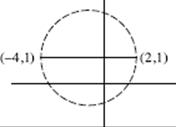
Then the area is π(3)2= 9π.
18. C. This question calls for a weighted average. The students in the first-period class earned a total of 24 × 78 = 1872 points, and the students in the second-period class earned 26 × 83 = 2158 points. In total, the 50 students earned 1872 + 2158 = 4030 points, so their average was ![]() = 80.6
= 80.6
![]() **The average of 78 and 83 is 80.5. However, since the group of students averaging 83 is slightly larger than the group with the 78 average, the average must be slightly greater than 80.5. Eliminate A and B and guess.
**The average of 78 and 83 is 80.5. However, since the group of students averaging 83 is slightly larger than the group with the 78 average, the average must be slightly greater than 80.5. Eliminate A and B and guess.
There’s no guarantee, but certainly, 80.6 is slightly greater than 80.5.
19. C. ![]() x = 2y – 5
x = 2y – 5 ![]() 2y = x + 5
2y = x + 5 ![]() y =
y = ![]() , so
, so
z = 16y3 = 16![]()
= ![]() = 2(x+5)3.
= 2(x+5)3.
**Use TACTIC 6: replace the letters with numbers. Let y = 2; then x = –1 and z = 16(2)3= 16(8) = 128. Which of the five choices equals 128 when x = –1? Only 2(x + 5)3.
20. D. The length of the rectangle is clearly 20, the length of two diameters.
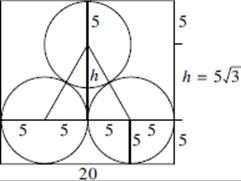
The width of the rectangle is 10 + h, where h is the height of the equilateral triangle formed by joining the centers of the three circles. Since the sides of that triangle are 10, the height is ![]() (KEY FACT J11). Then the width of the rectangle is 10 + 5
(KEY FACT J11). Then the width of the rectangle is 10 + 5![]() and its area is 20(10 + 5
and its area is 20(10 + 5![]() ) = 200 + 100
) = 200 + 100 ![]()
**Use TACTIC 2: trust the diagram. Clearly, the length is 20, and the width is much more than 10, but less than 20. You should even see that the width must be more than 15, so the area is between 300 and 400. Only ChoiceD is between 300 and 400.
Section 4 Writing Skills
1. A. Sentence is correct.
2. E. The original sentence lacks parallel structure.
Choices B and C are wordy and awkward.
Choice D is wordy. Only Choice E both corrects the error and produces an effective, concise sentence.
3. C. Lack of needed subordination. The sentence establishes a contrast. Most of Heyer’s books are set in the eighteenth century; one, however, is set in the eleventh century. Only Choice C establishes this contrast without introducing any fresh errors.
4. A. Sentence is correct.
5. D. Error in subject-verb agreement. Do not use as well as as a synonym for and. Only Choice D corrects the error.
6. C. Error in number. Because programs is plural, kind should be plural as well. The preferred form is these kinds of programs.
7. E. Errors in word usage and in parallelism. Do not use then, referring to time, in place of the function word than. The basic sentence states that modern men are less tolerant than men of old were. The revision in Choice E clarifies the meaning of the sentence.
8. C. Errors in verb form and idiom. Choice C both provides the noun clause with a verb (are transmitted) and introduces the noun clause properly with the preposition by.
9. D. The original sentence is both informal and redundant. By substituting stems from the desire for is because of wanting, you create a stronger, more effective sentence.
10. B. Dangling modifier. Ask yourself who was born in the days when no modest woman would admit to writing novels. The answer is Jane Austen. Choice B corrects the error by making Jane Austen the subject of a dependent clause.
11. A. Sentence is correct.
12. D. Error in word usage. Complimented means praised. The videotapes did not praise the exhibition; they made it complete. In other words, they complemented it.
13. E. Sentence is correct.
14. D. Sentence fragment. Change performing to performs. The ensemble performs without a conductor.
15. E. Sentence is correct.
16. D. Error in verb form. The passive voice is necessary here. The accidentally found objects do not discover anything. Instead they are discovered to be amazingly valuable.
17. D. Error in word usage. Change provoked from to provoked by.
18. C. Error in subject-verb agreement. A singular subject requires a singular verb. Culture is part of the complex mix.
19. A. Error in sequence of tenses. Since refuses is present tense, change had had to has had.
20. D. Errors in parallelism and in shift of pronoun.
Change your pursuit of to pursuing.
21. D. Error in pronoun-antecedent agreement. Who is encroaching on human territory? The black bear is. The antecedent is singular; the pronoun should be singular as well. Change their to its.
22. C. Error in subject-verb agreement. Do not let the unusual word order confuse you. The subject of the main clause is differences, plural.
Replace has with have.
23. C. Error in pronoun case. Here, the pronoun is the object of the preposition between. The sentence should read “between my brother and me,” not “between my brother and I.”
24. D. Error in word usage. People are indecisive (unable to make a decision); periods of time are indefinite (without a fixed or defined end). Replace indecisive with indefinite.
25. C. Error in parallelism. The correlatives “either…or“ are paired words that connect parallel structures. Replace and with or, so that the sentence reads “Some college students receive sufficient financial support for their education from either student loans or scholarship grants, but others must seek full-time employment.”
26. D. Error in logical comparison. Compare steaks with steaks, not steaks with meat markets.
Change Chelsea Meat Market to those at Chelsea Meat Market.
27. A. Error in word usage. Perspective is a noun meaning viewpoint or vista; prospective is an adjective meaning expected or future. The visitors are prospective or future tourists.
28. C. Error in subject-verb agreement. The subject Gold is singular; the verb should be singular as well. Replace are with is.
29. E. Sentence is correct.
30. D. Choices A, B, and C abruptly state the contrasting point of view without regard to the context.
Choice D takes the context into account and provides for a smooth progression of thought.
It is the best answer.
Choice E is confusing. It is unclear until the end of the sentence whether the other members support or oppose the exhibit.
31. D. Choice A is not consistent in style and mood with the rest of the paragraph.
Choice B is a sentence fragment.
Choice C is excessively wordy.
Choice D fits the context of the paragraph and expresses the idea correctly. It is the best answer.
Choice E inappropriately uses in conclusion and contains the pronoun it, which lacks a specific antecedent.
32. B. Choice A lacks a main verb; therefore, it is a sentence fragment.
Choice B accurately combines the sentences.
It is the best answer.
Choice C expresses the idea in a way that the writer could not have intended.
Choice D subordinates important ideas and emphasizes a lesser one.
Choice E restates the idea in a manner that changes the writer’s intended meaning.
33. A. Choice A is the best answer because sentences 10–12 contain basic information about the topic.
Readers are left in the dark unless the information appears as early as possible in the essay.
34. E. Choice A contains faulty idiom; the phrase than of the past is nonstandard usage.
Choice B contains a faulty comparison; society and the past cannot be logically compared.
Choice C contains an error in idiom; than from is redundant.
Choice D is correct but excessively wordy.
Choice E is the best answer.
35. C. Choice A provides a reasonable transition, but it contains an error in pronoun-antecedent agreement. The pronoun they is plural; its antecedent anyone is singular.
Choice B contains an error in diction. One can disapprove of but not disagree with a piece of art.
Choice C alludes to the content of the preceding paragraph and is clearly and succinctly expressed. It is the best answer.
Choice D contains an error in pronounantecedent agreement. The pronoun them is plural; the antecedent anyone is singular.
Choice E is inconsistent in tone and mood with the rest of the essay.
Section 6 Critical Reading
1. C. The sentence implies that Polynesian banquets are usually reputed to be good. The speaker was disappointed by the banquet. Two possibilities exist: either this banquet was a poor one, or the banquets in general are overrated (too highly valued).
Note how the “either...or” structure sets up a contrast between the two clauses.
(Contrast Signal)
2. B. The librarian has the committee’s acquiescence or agreement; they assent but do not go so far as to encourage or spur on the librarian.
Their support is of a lesser degree.
Note how the “with the...if not the” structure signals that the missing word and the noun encouragement must differ in meaning to some degree.
Remember: before you look at the choices, read the sentence and think of a word that makes sense.
Likely Words: agreement, permission, consent, approval
3. E. An endorsement is a testimonial or statement recommending a product for its virtues or good qualities.
Beware of Eye-Catchers. Choice A is incorrect. Though products have trademarks, trademarks are not statements of a product’s contents; they are names or logos manufacturers use to identify their products. (Definition)
4. A. His friends could not understand his outburst against his employers because he was usually dutiful (docile) and helpful (accommodating).
Remember: watch for signal words that link one part of the sentence to another. The presence of and linking a pair of items indicates that the missing word may be a synonym or near-synonym for the other linked word. In this case, docile and accommodating are near-synonyms. (Support Signal)
5. C. To be No. 1 at the box office, a film must attract or draw a large audience. Such popularity attests to its star’s drawing power, particularly if the film didn’t receive especially good reviews.
To say that the film’s reviews were modest at best is not high praise. It indicates that even the best of the reviews were lukewarm or middling. (Contrast Pattern)
6. C. The opening sentences simply present Hobbes’s thoughts on the nature of government.
7. D. You can answer this question by using the process of elimination.
Does the author of Passage 1 establish a time frame? Yes. She states that the English Civil War took place between 1642 and 1646; she also states that Locke wrote forty years after Hobbes did. You can eliminate (A).
Does the author contrast two differing viewpoints? Definitely. You can eliminate (B).
Does the author make an assertion? Yes. She asserts that Hobbes had a bleak view of human nature, that Locke had a more optimistic view, and so on. You can eliminate (C).
Does the author refute an argument? No. She merely states the arguments or beliefs of others. This is probably the correct answer. Just to be sure, check (E).
Does the author quote a source? Yes. She quotes Locke, citing his description of the disorder created by the absence of government.
You can eliminate (E).
Only (D) is left. It is the correct answer.
8. E. Passage 1 describes Hobbes’s view of human nature as “fearful and bleak.” Passage 2 states that fear of war plays a central role in his philosophy. Both passages indicate that his world view is inherently pessimistic.
9. C. The anecdote in Passage 1 about Hobbes’s premature birth (which was brought on by his mother’s fear of an attack by the Spanish fleet) confirms the statement in Passage 1 that his view of human nature was “fearful and bleak.”
10. C. In the opening paragraph the writer speaks of the Gothic world in terms of play and extravagance, of the fantastic and the luxurious. In other words, he speaks of it in terms of its elaborateness of fancy or fantasy.
Choices A and B are incorrect. They are unsupported by the passage.
Choices D and E are incorrect. They are attributes of the medieval imagination, not of the Gothic.
11. E. For architecture to reach “a point of extravagance unequalled in history” is for it to achieve an unparalleled degree of lavishness and excess.
12. D. The author has just described the extraordinary degree of wastefulness and excess in the Gothic period. He then notes something somewhat paradoxical. Despite the worldly extravagance of the period, it produced the saintly Francis of Assisi and the religious poet Dante.
By citing these two great spirits, the author corrects a potential misapprehension. He thus refutes the notion that the Gothic period produced nothing but extravagance.
13. D. The tapestries combine worldly elements (mythological beasts that symbolize lust and ferocity, wild creatures that symbolize fertility) with spiritual ones (the lady who embodies chastity) to express “the power of love.”
Choice A is incorrect. It is unsupported by the passage.
Choice B is incorrect. Though the Gothic imagination has a “sharp sense of reality” (lines 14 and 15), it is more inclined to be playful than to be practical.
Choice C is incorrect. Nothing in the passage suggests that wall hangings are wasteful.
Choice E is incorrect. It is unsupported by the passage.
14. D. The tapestries are known as The Lady with the Unicorn. In the central tapestry, the lion and the unicorn kneel before the lady, who gently, irresistibly, subdues the forces of nature.
15. D. “To draw carts of stones up the hill for the building of Chartres Cathedral” is to haul the stones used to construct the cathedral. In doing such hard manual labor, the noble knights and ladies showed the depth of their conviction or belief.
16. D. Step by step, the author traces the course of a surgical procedure, from the initial grasping of the scalpel through the opening incision to the eventual sensory exploration of the internal organs. In doing so, he is describing a process.
17. C. As the surgeon draws the knife across the skin, it leaves a thin line of blood in its wake (path or track passed over by a moving object).
18. B. To part the flesh is to split or separate the skin.
19. E. The “strange flowers” with their looped handles are the hemostats, forceps, and other surgical tools attached to the opening.
20. D. To write of one object by using a term that normally indicates a different object, suggesting a likeness between them, is to make an implicit comparison, that is, to be metaphorical.
21. B. The simile “like children absorbed in a game” indicates that in this context “engaged” means engrossed or deeply involved.
22. D. Primitive drawings of buffalo and other wild beasts still exist in caves in which prehistoric humans dwelled.
23. E. Writing of “ritual cleansing,” entering the “temple” of the human body, the truth hidden in the “ark” or holy place, the author is referring to priestly or religious observances (rites).
24. C. The author freely uses technical names for various body organs—“fascia,” “peritoneum,”
“omentum”—tossing in occasional descriptive adjectives or phrases as if he assumes the reader is already able to visualize these organs in some detail. Readers without much background in anatomy might well feel the need for additional information about these organs (size, function, specific location) in order to appreciate the passage fully.
Section 7 Mathematical Reasoning
MULTIPLE-CHOICE QUESTIONS
1. A. Since the area of the square is 25, its sides are 5, and its perimeter is 20. Since the perimeter of the pentagon is also 20, each of its sides is 4.
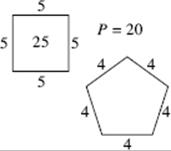
2. D. Going at ![]() of Mary’s speed, John took 3 times as long: 3 × 30 = 90 minutes.
of Mary’s speed, John took 3 times as long: 3 × 30 = 90 minutes.
3. C. ![]()
Use TACTIC 6: plug in a number for x. If
x = 2, then ![]() . Only choice C is equal to
. Only choice C is equal to ![]() where x = 2:
where x = 2:![]() =
= ![]() .
.
4. B. The formula for the volume of a cylinder, which is given to you in the reference box, is V = ![]() r2h. The first cylinder has a height of 4 and a radius of 2. Its volume is
r2h. The first cylinder has a height of 4 and a radius of 2. Its volume is ![]() (22)4 = 16
(22)4 = 16![]() . The second cylinder has a height of 2 and a radius of 4. Its volume is
. The second cylinder has a height of 2 and a radius of 4. Its volume is ![]() (42)2 = 32
(42)2 = 32![]() . The volume of the first cylinder is
. The volume of the first cylinder is ![]() the volume of the second cylinder.
the volume of the second cylinder.
5. E. If x is even, then every multiple of x is even and xn is even for any positive integer n. So, x, 2x, 3x, 5x, x2, 3x2, and x3 are all even.
Finally, the sum of any two even numbers is even, and the sum of an even number and an odd number is odd. Therefore, choices A–D are all true. Choice E is the product of two odd numbers and so is odd.
**Use TACTIC 6 and replace x with a simple even number, such as 2. Then evaluate each of the choices to see which one is not true. When x = 2, (3x – 5)(5x – 3) = (1)(7) = 7, which is odd. Choice E is not true.
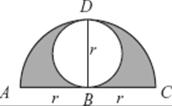
6. C. AB, BC, and BD are all radii of the semicircle.
If r is the radius, then the area of the semicircle is ![]()
![]() r2. Since r is the diameter of the circle, the circle’s radius is
r2. Since r is the diameter of the circle, the circle’s radius is ![]() r and its area is
r and its area is ![]()
![]() 2 =
2 = ![]()
![]() r2. Then the area of the shaded region is
r2. Then the area of the shaded region is ![]()
The area of the shaded region and the area of the unshaded region are equal. Therefore, the probability that the point is in the shaded region is ![]()
**Do exactly the same thing but let r = 2.
Then the total area is 2![]() and the shaded area is
and the shaded area is ![]() .
.
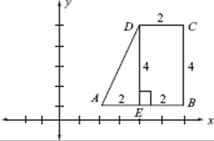
7. B. Sketch quadrilateral ABCD, and draw DE perpendicular to AB. Then the area of rectangle BCDE is 2 × 4 = 8, and the area of right ![]() AED is
AED is ![]() (2)(4) = 4. The total area is 12.
(2)(4) = 4. The total area is 12.
8. D. To get the graph on the bottom, the graph on the top was shifted 2 units to the right and 2 units up. By KEY FACT R2 its equation is y = f(x – 2) + 2.
GRID-IN QUESTIONS
9. (1) 
10. (9) ab = 20 and a = –5 ![]() –5b = 20
–5b = 20 ![]() b = –4, so a2 – b2 = (–5)2+ (–4)2= 25 – 16 = 9.
b = –4, so a2 – b2 = (–5)2+ (–4)2= 25 – 16 = 9.
11. (0) If a ≠ b and ax = bx, then x must be 0.
Therefore ![]() x=
x= ![]() x
x ![]() x = 0
x = 0 ![]()
![]() x = 0.
x = 0.
12. (11) Between 12:10 A.M. and 2:40 P.M., for example, the clock chimes once every 15 minutes, beginning at 12:15 and continuing to 2:30, except twice at 2:00: a total of 11 times.
13. ![]() There are five integers less than 50 whose units digit is 7: 7, 17, 27, 37, and 47. Of these, four (all but 27) are prime. Then, the probability of drawing a prime is
There are five integers less than 50 whose units digit is 7: 7, 17, 27, 37, and 47. Of these, four (all but 27) are prime. Then, the probability of drawing a prime is ![]()
14. (345) ![]() Since the average amount of savings for the 10 students is $60, the total amount they have all saved is $600 (TACTIC E1). John has $130, and 3 students have no savings at all. If 5 other students have $125 total ($25 each, the least possible), then the tenth student will have $600 – $130 – $125 = $345.
Since the average amount of savings for the 10 students is $60, the total amount they have all saved is $600 (TACTIC E1). John has $130, and 3 students have no savings at all. If 5 other students have $125 total ($25 each, the least possible), then the tenth student will have $600 – $130 – $125 = $345.
15. (348) ![]() You don’t need to add up the lengths of the steps. Together, all the horizontal steps are equal to the bottom, and all the vertical risers are equal to the left side. The sum of the left side, 5 feet 4 inches, or 64 inches, and the bottom, 9 feet 2 inches, or 110 inches, is half the perimeter. The perimeter is
You don’t need to add up the lengths of the steps. Together, all the horizontal steps are equal to the bottom, and all the vertical risers are equal to the left side. The sum of the left side, 5 feet 4 inches, or 64 inches, and the bottom, 9 feet 2 inches, or 110 inches, is half the perimeter. The perimeter is ![]()
**Of course, if you don’t see this, you can just use your calculator to add everything.
16. ![]() Since the area of a right triangle is
Since the area of a right triangle is ![]() the product of its legs, the area is
the product of its legs, the area is ![]() (3)(4) = 6.
(3)(4) = 6.
But the area can also be calculated as ![]() bh.
bh.
Since this is a 3-4-5 triangle, the base is 5, so 6 = ![]() (5)h
(5)h ![]() 5h = 12
5h = 12 ![]() h =
h = ![]() or 2.4.
or 2.4.
**There are several other ways to get this answer if you know more than the basic geometry required for the SAT. For example, the little triangle on the left in the figure is similar to the large one, and the ratio of the hypotenuse of the small triangle to the hypotenuse of the large triangle is 3:5. Then, 3:5 = h: 4 ![]() h = 2.4
h = 2.4
17. (100) c = a% of a% of b = ![]() × b =
× b = ![]() , and kc = a2% of b =
, and kc = a2% of b = ![]() b. Then
b. Then
![]() = kc = k
= kc = k ![]()
![]()
![]() =
= ![]()
![]()
100k = 10,000 ![]() k = 100.
k = 100.
**Use TACTIC 6: replace the variables with numbers. If a = 10 and b = 100, 10% of (10% of 100) = 10% of 10 = 1, so c = 1; but (10)2% of 100 = 100% of 100 = 100.
Then kc = 100 ![]() k = 100.
k = 100.
18. (21) Since the average of the three digits is 2, the sum of the digits is 6. The simplest thing is to list them. If there are only a few, list them all; if it seems that there will be too many to list, look for a pattern. The list starts this way:
105, 114, 123, 132, 141, 150, so there are 6 positive three-digit numbers in the 100’s.
Continue: 204, 213, 222, 231, 240; there are 5 in the 200’s. You can conclude, correctly, that there are 4 in the 300’s, 3 in the 400’s, 2 in the 500’s, and 1 in the 600’s. The total is 6 + 5 + 4 + 3 + 2 + 1 = 21. If you don’t spot the pattern, just continue the list: 303, 312, … ,501, 510, 600.
Section 8 Critical Reading
1. D. If something falls into decay or disintegrates, by definition it must be perishable or subject to decay.
(Cause and Effect)
2. C. Since Lee avoided or refrained from excesses, Grant, his opposite, must have indulged in or satisfied his taste for excesses.
The key words in this sentence are “differed markedly.” They set up the contrast between the two men.
Note that you are looking for a word that suggests Grant enjoyed drinking. Therefore, you can eliminate any word that suggests he disliked or disapproved of it. Choices A, B, and D all suggest dislike or disapproval. They are clearly incorrect. Choice E, compensated for, suggests neither disapproval nor dislike.
However, it makes no sense in the context.
Choice C is the correct answer.
(Contrast Pattern)
3. D. Someone given to starting casual conversations with total strangers is by definition gregarious or sociable.
(Definition)
4. A. With no enemies to stop their spread, the deer thrived. In fact, they did so well that they “overgrazed” or ate too much grass.
This threatened (was bad for) the vegetation.
Note how the “to such an inordinate degree…that” structure signals cause and effect.
Remember: in double-blank sentences, go through the answer choices, testing the first word in each choice and eliminating the ones that don’t fit. You can immediately eliminate Choices C and E.
(Cause & Effect Signal)
5. D. The negotiations have degenerated or deteriorated; they have become acrimonious (bitter). The phrase following the blank gives an example of what the sessions are like. They are degenerating into a welter or turmoil of accusations and countercharges.
Note that you are looking for a word with negative associations. Therefore, you can eliminate any word with positive ones. Choices A, C, and E all have positive associations. Only Choice B or Choice D can be correct. Choice C, phlegmatic (slow and stolid; undemonstrative), is an inappropriate word to describe a wild turmoil of accusations. By process of elimination, the correct answer must be acrimonious, Choice D.
(Examples)
6. D. One would protest a system deliberately or intentionally designed to demean (degrade or debase) human dignity.
Choices A, B, and E are incorrect. One would be unlikely to protest a system that reflected, fostered (nourished), or enhanced (improved) human dignity.
Choice C is also incorrect. Assess (evaluate) is inappropriate in the context.
(Definition)
7. B. The energy of American life springs or arises from various factors enumerated by the author.
Remember: when answering a vocabulary-incontext question, test each answer choice, substituting it in the sentence for the word in quotes.
8. E. Use the process of elimination to answer this question.
Choice A is incorrect. The lover of business is enthusiastic; he applies zeal or enthusiasm to the task at hand.
Choice B is incorrect. The lover of business is engrossed in his work because of its “absorbing, satisfying character” (lines 35 and 36).
Choice C is incorrect. The lover of business is enterprising, industriously devoting himself to making the business “greater and better organized” (line 27).
Choice D is incorrect. The lover of business is industrious; he applies himself to the task at hand with “zeal and intensity” (line 31).
Only Choice E is left. It is the correct answer.
The lover of business is not ruled by the love of money or material advantages. He is clearly not mercenary.
9. A. Lines 25–28 plainly state that American lovers of business find joy or pleasure in making businesses greater and better organized. Thus, Americans clearly must find the prospect of improving business organizations pleasurable.
10. E. The word “engine” here is used metaphorically to indicate a driving force in society. The lover of business wants his organization to be a powerful force in the world.
11. C. The concluding sentence of Passage 1 states that “in beginning life in such a society, which has developed a native and vital tradition” of business, young people will come to “realize a part of what [they] are living for.” In other words, they will be influenced to find selffulfillment or self-realization through their business activities.
12. B. The author states that technological advances have wiped out cultural differences so thoroughly that the time may come when “it will be impossible to distinguish human beings living on one area of the earth’s surface from those living on any other.” In other words, he asserts that these advances may eventually lead to worldwide cultural sameness or uniformity.
13. B. A striking difference is marked or noticeable; it immediately strikes the eye.
14. E. To take something for granted is to accept it without question or objection, in other words, to assume it.
15. B. If a man made less money than his father did, Americans assumed the fault was his. A son’s failure to surpass his father in income was proof that the son had not worked hard enough (“was lazy”) or had not worked effectively (“was...inefficient”). In other words, he had not applied himself properly to the task.
16. E. If the rentier is doing nothing to increase his inherited wealth, he is “doomed” to a life of drunkenness or psychoanalysis. Clearly, the author feels no sympathy for the sufferings of this poor little rich man. Instead, he views the rentier with sardonic irony.
17. E. Use the process of elimination to answer this question.
Choice A is incorrect. The assertion “In no society in history have rich men given away so large a part of their fortunes” is a categorical statement.
Choice B is incorrect. The author corrects a misapprehension about how profitable slave labor was to Southern slave owners.
Choice C is incorrect. Throughout the passage the author contrasts the European and American attitudes toward money.
Choice D is incorrect. In the passage’s final sentence, the author poses a question.
Only Choice E is left. It is the correct answer.
Throughout the passage, the author never refers to or cites an authority.
18. E. The author of Passage 1 asserts that American men engage in business for the sheer love of business activities. The author of Passage 2 asserts they do so out of a sense of Oedipal rivalry with their fathers. However, both authors would agree that Americans engage in business for psychological rather than financial reasons.
19. C. The author of Passage 1 is making a commencement address to students about to graduate from an American college. Appropriately enough, he addresses them positively, expressing an optimistic view of American traditions and society. The British author of Passage 2, however, has a far more cynical view of Americans, who are (in his opinion) far less rational than their European counterparts.
Section 9 Mathematical Reasoning
1. E. Be careful with the minus signs and the negatives: (–2)4– (–2)3+ (–2)2– (–2) = 16 – (–8) + 4 – (–2) = 16 + 8 + 4 + 2 = 30.
2. C. The weight of the mixture is 9 (3 + 1 + 5) pounds, of which 3 pounds are peanuts.
Hence, the desired fraction is ![]() =
= ![]()
3. C. The largest possible sum of the digits for the minutes is 14, when the time is 59 minutes after the hour. Therefore, the first time that the sum of all the digits can be 20 occurs when the hour is 6: at 6:59 we have 6 + 5 + 9 = 20.
Since 6:59 is 3 hours and 12 minutes after 3:47, and since 3 hours is 180 minutes, this sum of 20 will occur after 180 + 12 = 192 minutes.
4. E. The expression ![]() is defined only if x –
is defined only if x – ![]() ≥ 0, so x ≥
≥ 0, so x ≥ ![]() . The smallest integer greater than π is 4. But if x were 4, the denominator of
. The smallest integer greater than π is 4. But if x were 4, the denominator of ![]() would be 0, and f(4) is not defined. The smallest integer for which f(x) is defined is 5.
would be 0, and f(4) is not defined. The smallest integer for which f(x) is defined is 5.
5. B. Since w = 40, arc ![]() is
is ![]() =
= ![]() of the circumference. Arc
of the circumference. Arc ![]() is the same length, so the total length of the two arcs is
is the same length, so the total length of the two arcs is ![]() of the circumference.
of the circumference.
**The two arcs add up to 80°, which is less than 90°, a quarter of the circle. Therefore, the answer is less than ![]() : eliminate C, D, and E.
: eliminate C, D, and E.
Also, since ![]() = 0.111..., which is much too small, eliminate A.
= 0.111..., which is much too small, eliminate A.
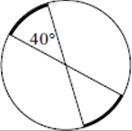
**Use TACTIC 3: redraw the diagram.
Clearly, the two arcs take up more than ![]() , but much less than
, but much less than ![]() , of the circumference; even
, of the circumference; even ![]() is way too big.
is way too big.
Eliminate A, D, and E, and guess between ![]() = 0.222 and
= 0.222 and ![]() = 0.25, which are too close to distinguish just by looking.
= 0.25, which are too close to distinguish just by looking.
6. A. Assume Phil sold only one phone of each model. Then his total sales were $450
($100 + $125 + $225), so ![]() =
= ![]() of the total sales were attributable to the cheapest phone.
of the total sales were attributable to the cheapest phone.
Changing to percents gives:
![]() =
= ![]() (100)% = 22
(100)% = 22 ![]() %
%
7. C. Pick a value for a side of the square, say 2.
Then the area of the square is 4. Since the diameter of the circle is also 2, the radius is 1, and the area of the circle is ![]() . Then the area of the unshaded region is 4 –
. Then the area of the unshaded region is 4 – ![]() , and the probability that the chosen part is in the shaded region is
, and the probability that the chosen part is in the shaded region is ![]() ≈ 0.214. Of the choices, 0.2 is the closest.
≈ 0.214. Of the choices, 0.2 is the closest.
8. D. ![]() Driving at 50 miles per hour, Gilda took 650 ÷ 50 = 13 hours for the trip. In order for the trip to have taken only 12 hours, she would have had to drive at a rate of
Driving at 50 miles per hour, Gilda took 650 ÷ 50 = 13 hours for the trip. In order for the trip to have taken only 12 hours, she would have had to drive at a rate of
650 ÷ 12 = 54 ![]() miles per hour, or
miles per hour, or ![]() miles per hour faster.
miles per hour faster.
9. C. If a team won w of the g games it played, it lost the rest: g – w. The fraction is ![]()
**Use TACTIC 6: plug in easy-to-use numbers. If the team won 2 of its 3 games, it lost ![]() of them. Only
of them. Only ![]() equals
equals ![]() when g = 3 and w = 2.
when g = 3 and w = 2.
10. B. Currently, 25% + 30% + 35% = 90% of the students are taking a course other than physics, so 10% are taking physics. Since 20% of 35% is 7%, if 20% of the chemistry students transfer to physics, the percent of students taking physics will be 10% + 7% = 17%.
**Assume there are 100 students at Central High School. Then 35 of them are taking chemistry, and 10 are taking physics. Since 20% of 35 = 7, there will be 17 students taking physics.
11. C. Since, in 2010, 2p pounds of potatoes cost ![]() d dollars, p pounds cost half as much:
d dollars, p pounds cost half as much: ![]()
![]() or
or ![]() d. This is
d. This is ![]() , or 25%, as much as the cost in 2000, which represents a decrease of 75%.
, or 25%, as much as the cost in 2000, which represents a decrease of 75%.
**In this type of problem it is often easier to use TACTIC 6. Assume that 1 pound of potatoes cost $100 in 2000. Then in 2010, 2 pounds cost $50, so 1 pound cost $25. This is a decrease of $75 in the cost of 1 pound of potatoes, and

12. A. Use TACTIC 7. Choose an appropriate number for the common perimeter. Any number will work; but since a triangle has 3 sides and a square has 4 sides, 12 is a good choice.
Then, each side of the square is 3, and its area is 32 = 9. Each side of the equilateral triangle is 4, and its area is ![]() =
= ![]() (KEY FACT J15). The ratio is
(KEY FACT J15). The ratio is ![]() .
.
13. C. The slope of AB is ![]() . Then the slope of any line perpendicular to AB is the negative reciprocal of
. Then the slope of any line perpendicular to AB is the negative reciprocal of ![]() , namely, –
, namely, – ![]()
14. D. Since there are 4 numbers (1, 2, 3, –4) in the repeating set, divide 150 by 4: 150 ÷ 4 = 37.5.
This means that in the first 150 terms there are 37 complete groups of the 4 numbers.
The sum of the numbers in each group is 1 + 2 + 3 – 4 = 2, so the sum of the numbers in the 37 groups is 37 × 2 = 74. Finally, note that 37 × 4 = 148. Then the sum of the first 148 terms is 74. The next 2 terms are 1 and 2, so the sum of the first 150 terms is 74 + 1 + 2 = 77.
15. A. Since the radius of circle O is 5, AB = 10. Also, since ![]() ACB is a right triangle whose hypotenuse, AB, is 10 and one of whose legs is 6, the other leg, BC, is 8. (If you dont recognize this as a 6-8-10 triangle, use the Pythagorean theorem.) The circumference of a circle whose diameter is 10 is 10
ACB is a right triangle whose hypotenuse, AB, is 10 and one of whose legs is 6, the other leg, BC, is 8. (If you dont recognize this as a 6-8-10 triangle, use the Pythagorean theorem.) The circumference of a circle whose diameter is 10 is 10![]() , so the length of the semicircle is 5
, so the length of the semicircle is 5![]() . The perimeter is the sum of the lengths of the semicircle and the two legs of the triangle: 6 + 8 + 5 = 14 + 5
. The perimeter is the sum of the lengths of the semicircle and the two legs of the triangle: 6 + 8 + 5 = 14 + 5![]() .
.
16. D. Let B be the sum of all the positive odd integers less than 1000.
![]()
A is the sum of 499 even integers, each of which is 1 more than the corresponding odd integer in B. Then (1 + 3 + 5 + ··· + 997) = A – 499, and B = (A – 499) + 999 = A + 500.
Section 10 Writing Skills
1. E. Error in usage. The verb raise means cause to move upward, lift, increase. It is transitive, as in “Raise your hand!” The verb rise means get up, move up, ascend. It is intransitive, as in “Rise up and sing!” When manufacturers raise prices, our expenses rise. Choice E uses raise correctly.
2. D. Error in pronoun choice. Avoid shifting from one pronoun to another within a single sentence. ChangeWhen one realizes to When you realize.
3. B. Ineffective sentence. Do not string two main clauses together with and unless both clauses deserve equal emphasis. Choice B, through its use of subordination, effectively emphasizes the idea that the della Robbias worked in terra-cotta.
4. B. Wordiness. Do not use when after is when you are defining a term. Choice B eliminates unnecessary words to create a strong, effective sentence.
5. E. Adjective-adverb confusion. Change eager anticipated to eagerly anticipated.
6. C. Run-on sentence. Use a comma between main clauses only when they are linked by a coordinatingconjunction (and, but, etc.). Choice C corrects the error by replacing the original construction with a subordinate clause.
7. C. Choice C strengthens the sentence by correcting the error in parallelism and clarifying the cause-and-effect relationship: because Thorpe excelled in sports, therefore people acclaim him.
8. A. Sentence is correct. Unique means being without a like or equal. Avoid phrases like very unique and more unique that imply there can be degrees of uniqueness.
9. C. Remember: any sentence elements that are not underlined are by definition correct. Here, the coordination conjunction but is not underlined.
Coordinating conjunctions connect sentence elements that are grammatically equal. In this case, but should connect the main clause beginning “others restrict themselves” with another main clause. However, while, a subordinating conjunction, introduces a subordinate, not a main, clause. To correct the error, delete While and begin the sentence with Some scientists are absorbed.
10. A. Sentence is correct.
11. A. Sentence is correct.
12. A. Sentence is correct.
13. D. The revised sentence is stronger and less vague than the original both because it eliminates the weak there is construction and introduces the pronoun we.
14. C. Sentence fragment. Choice C corrects the fragment by providing a verb, are, without introducing any new errors.
Pronunciation Key*
|
|
as in pat |
|
|
as in play and maid |
|
ah |
as in bother and hot |
|
ahr |
as in car |
|
|
as in Mary and fair |
|
aw |
as in paw |
|
ow |
as in how and cloud |
|
|
as in pet and cherry |
|
|
as in see |
|
|
as in ear and peer |
|
|
as in pit |
|
|
as in pie and my |
|
|
as in toe and grow |
|
oi |
as in point and toy |
|
|
as in above and cactus |
|
|
as in purr and pert |
|
|
as in school and mule |
|
|
as in full and good |
|
ng |
as in Ping-Pong |
*Note: Pronunciation often tends to be regional and you may find that you pronounce a word differently than what is shown. These guidelines are meant to give you a general idea of the pronunciation (to distinguish between the adjective, verb, or noun forms of the word, for example), and are based primarily on the first-listed pronunciation in Merriam Webster’s Collegiate Dictionary, Eleventh Edition.